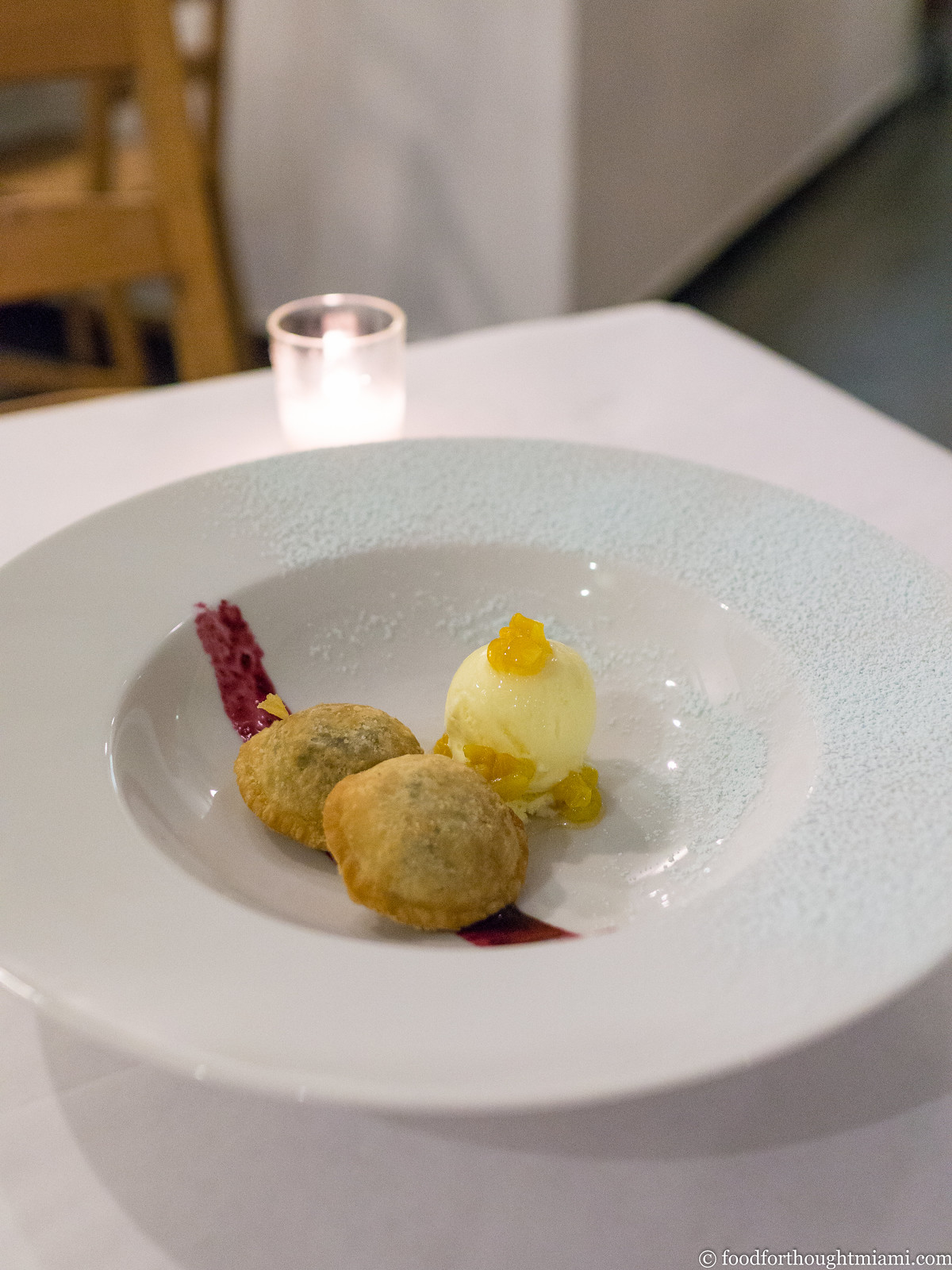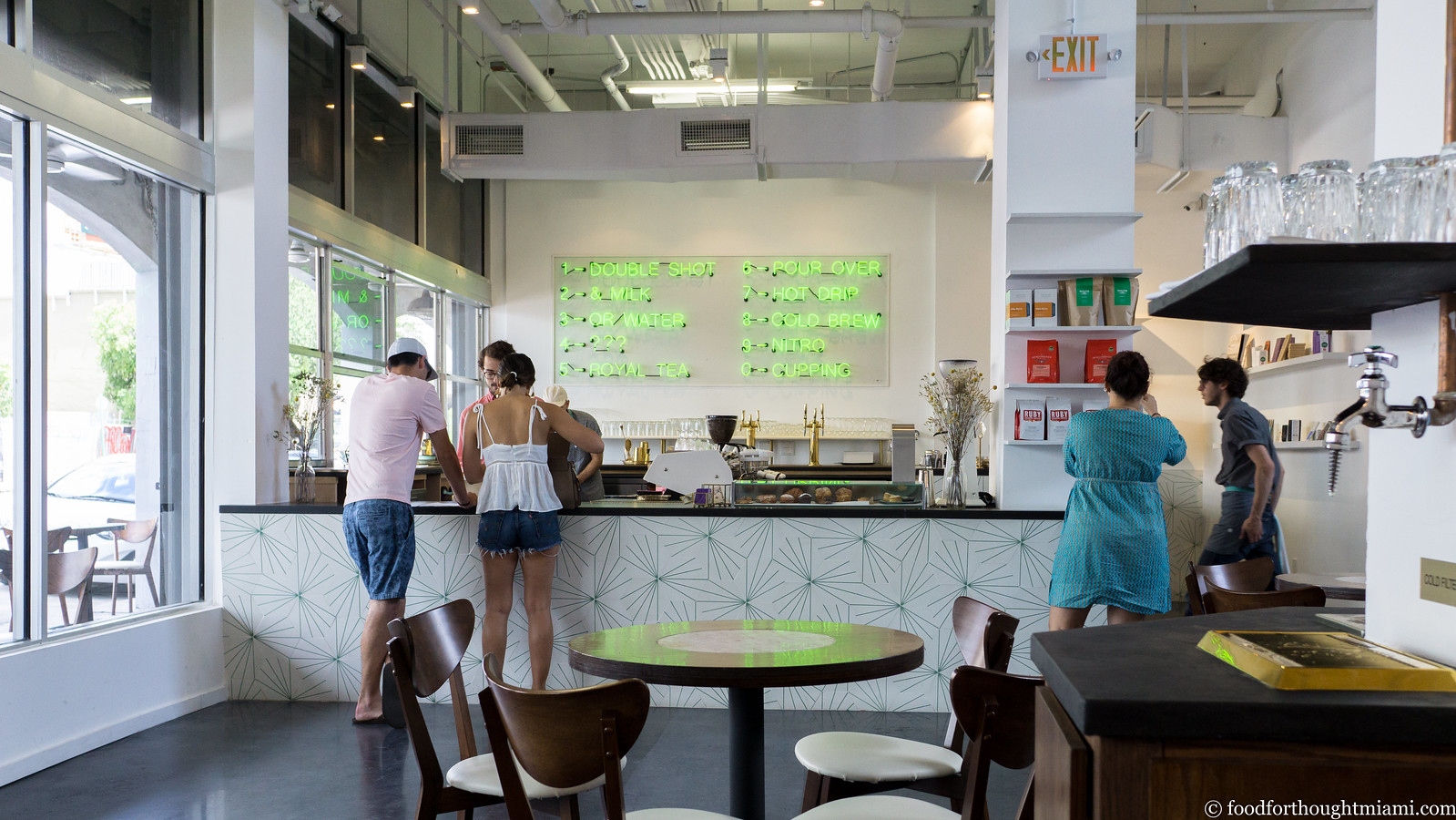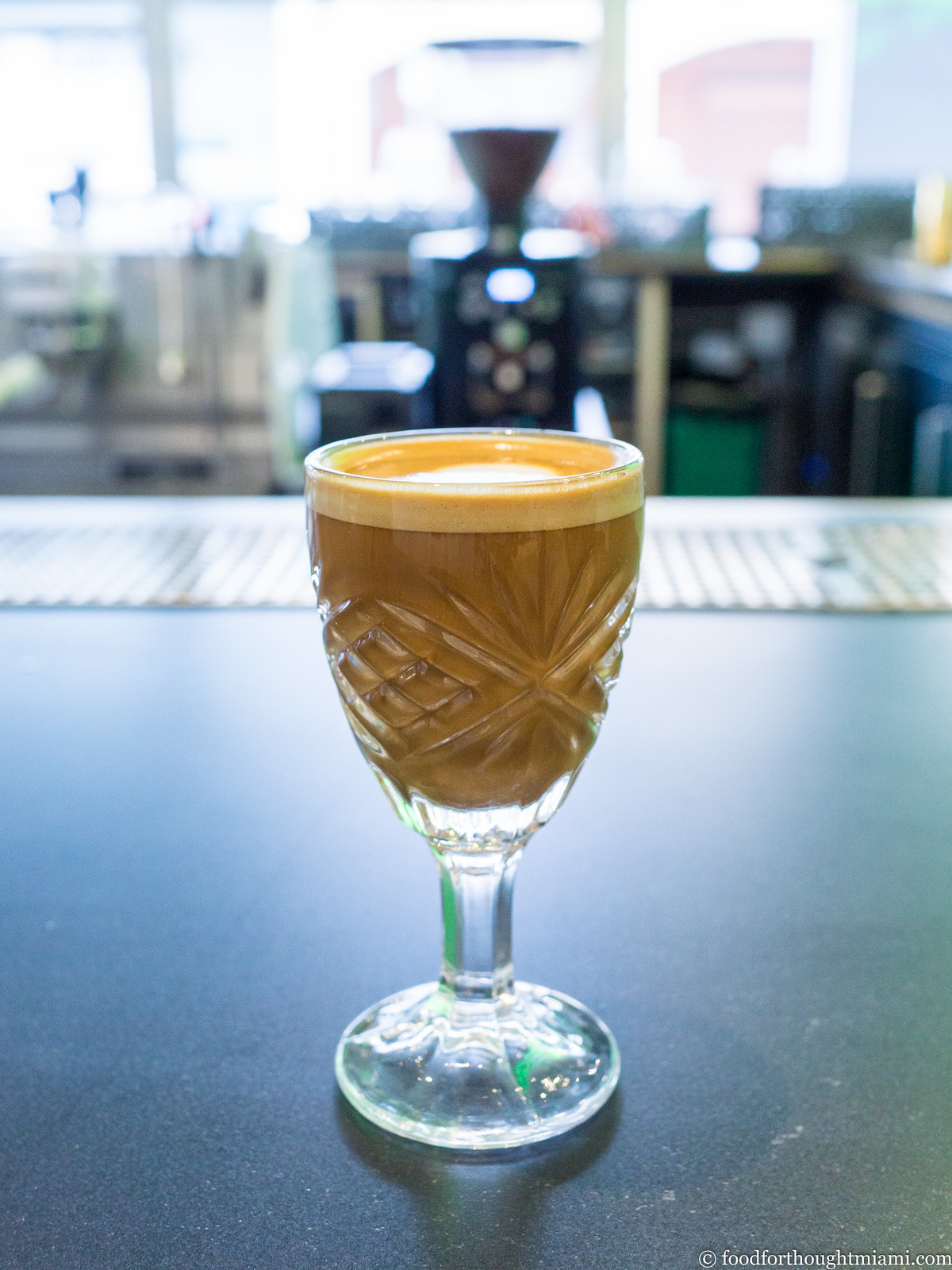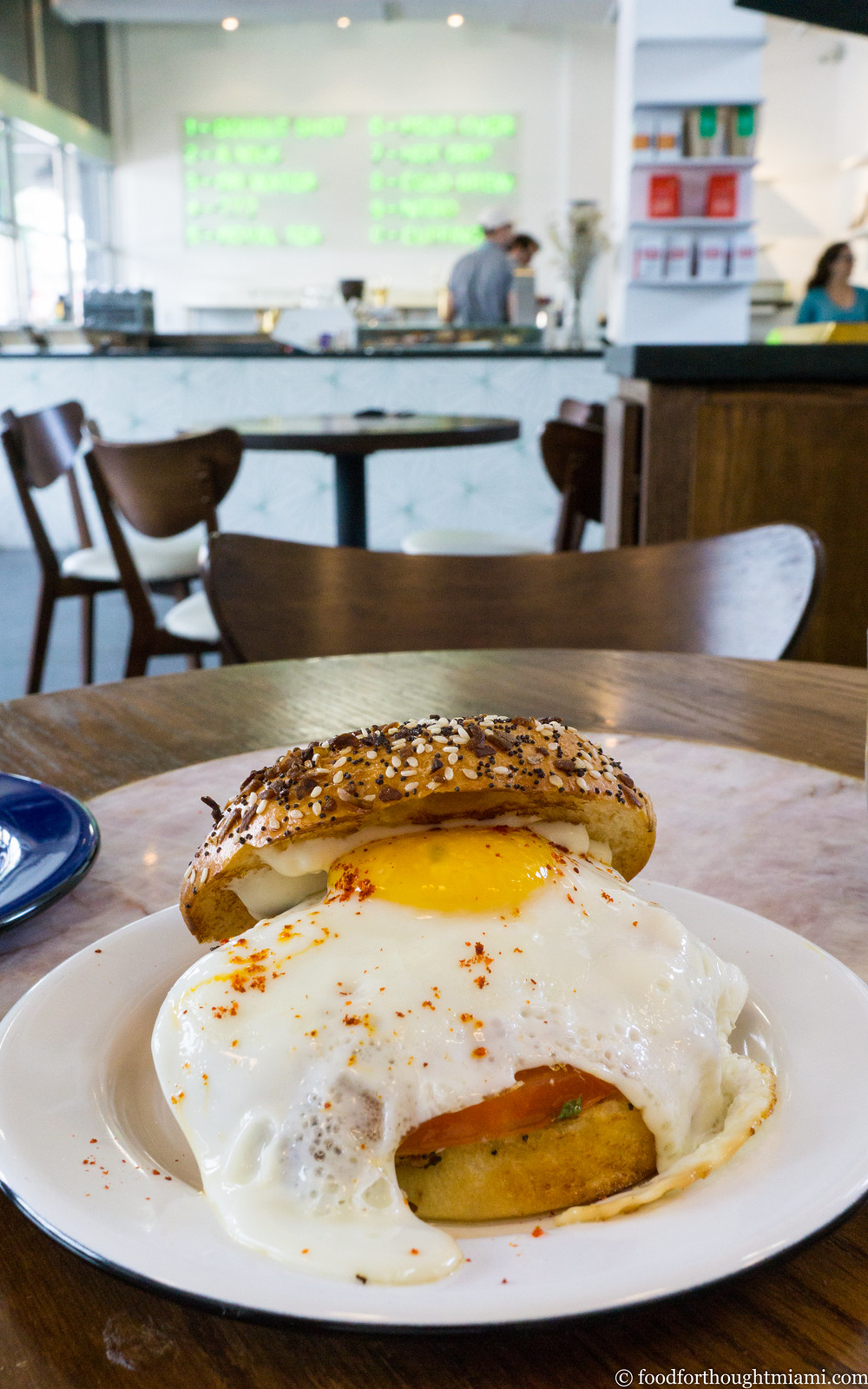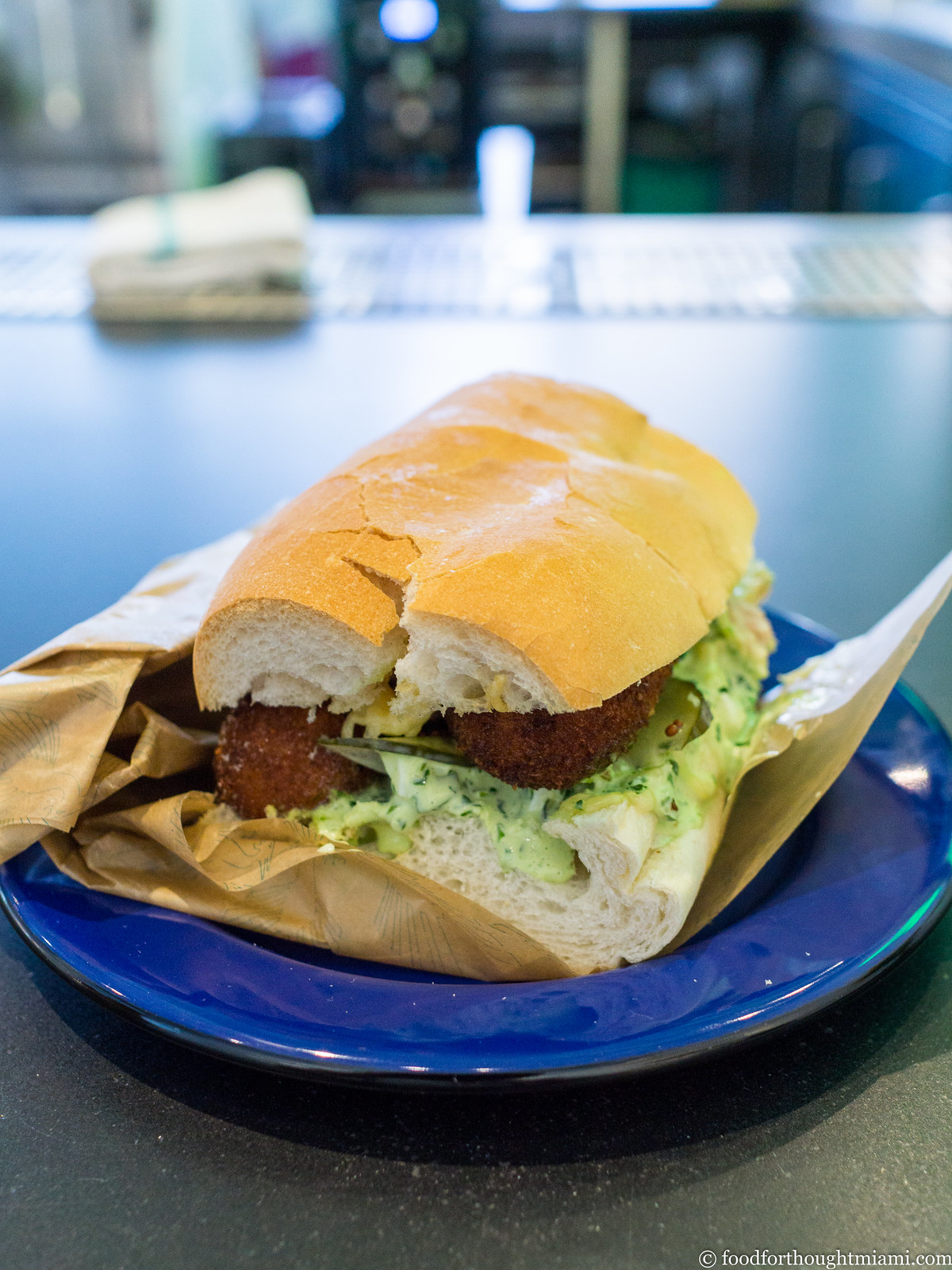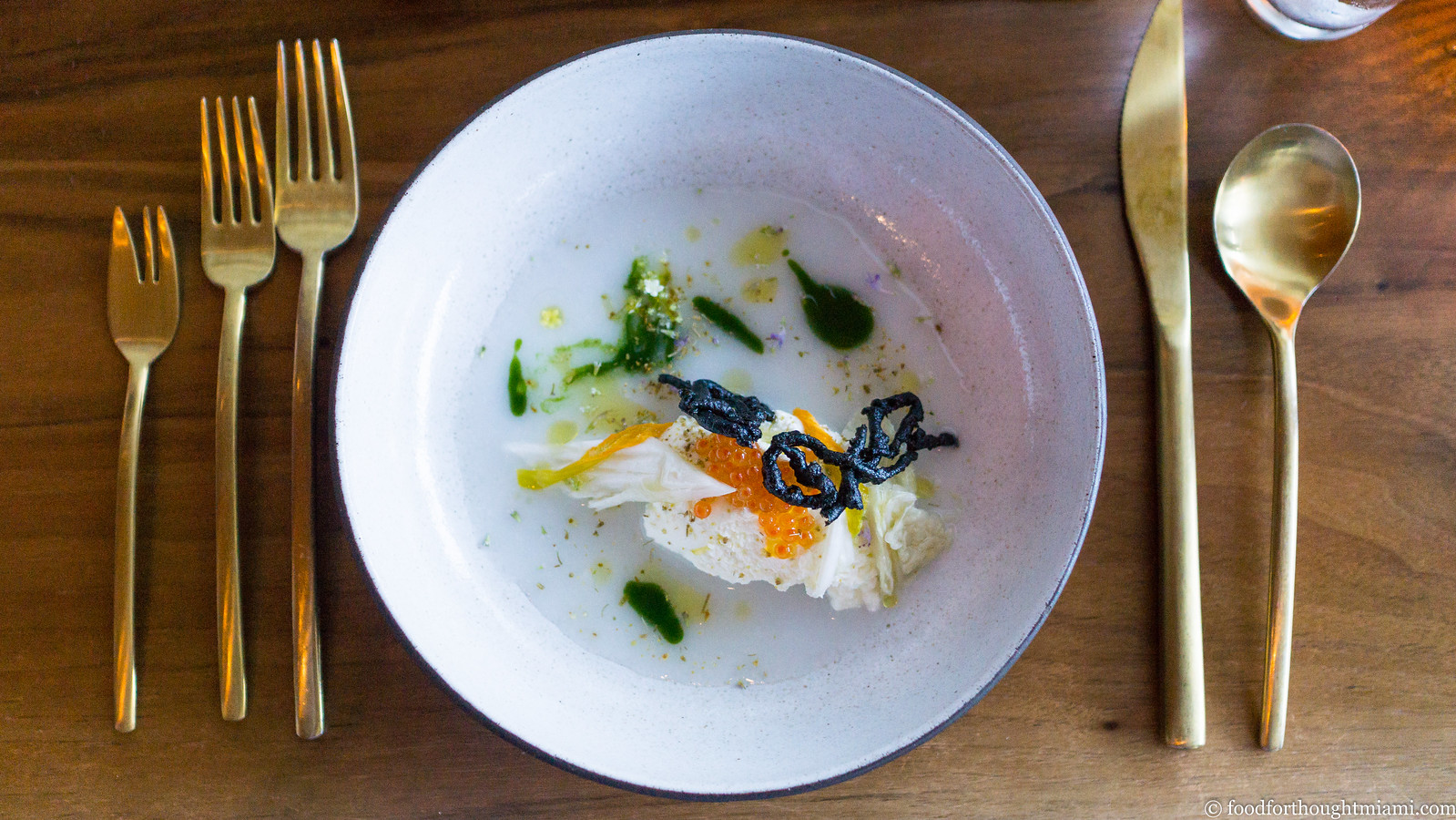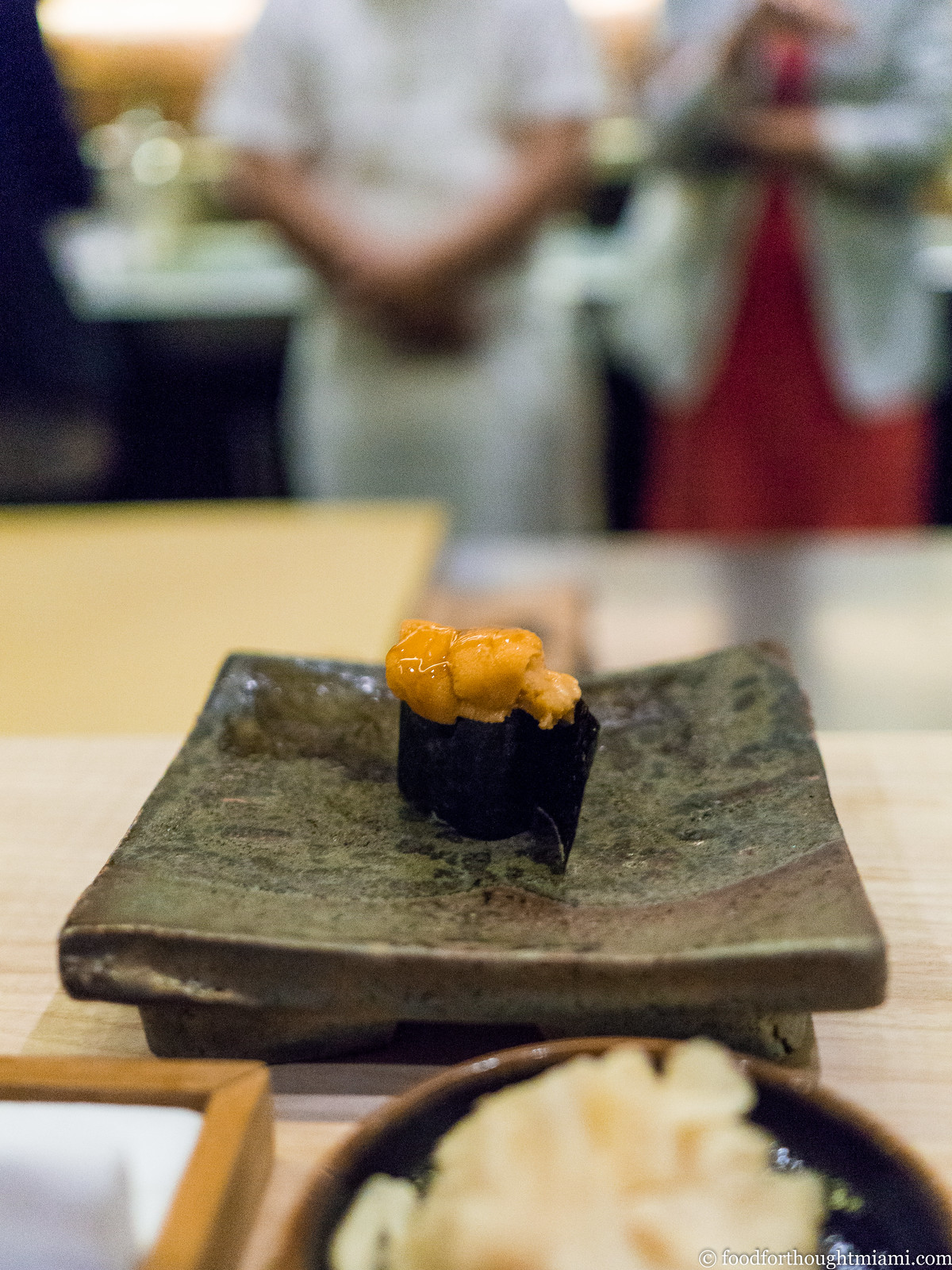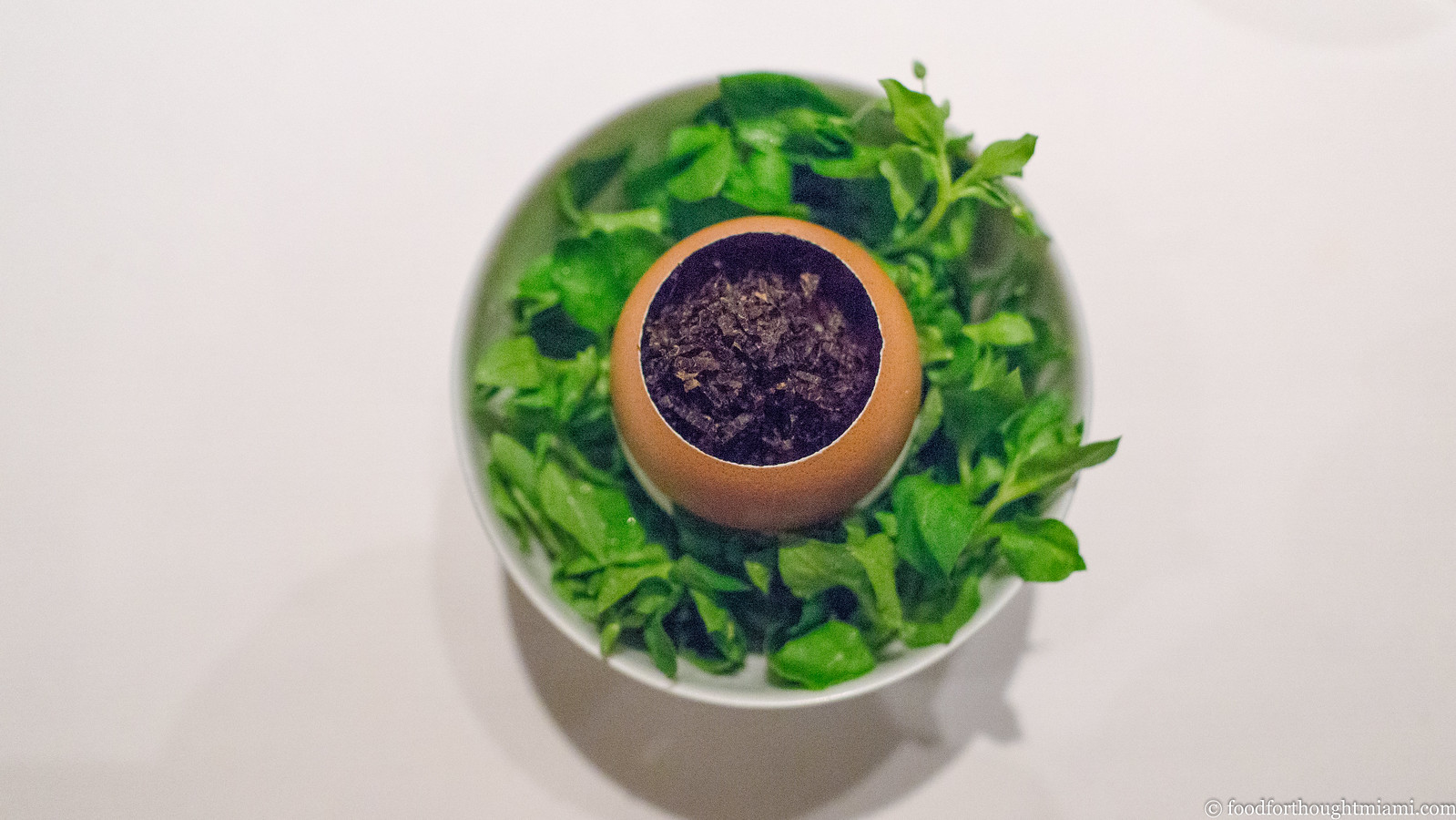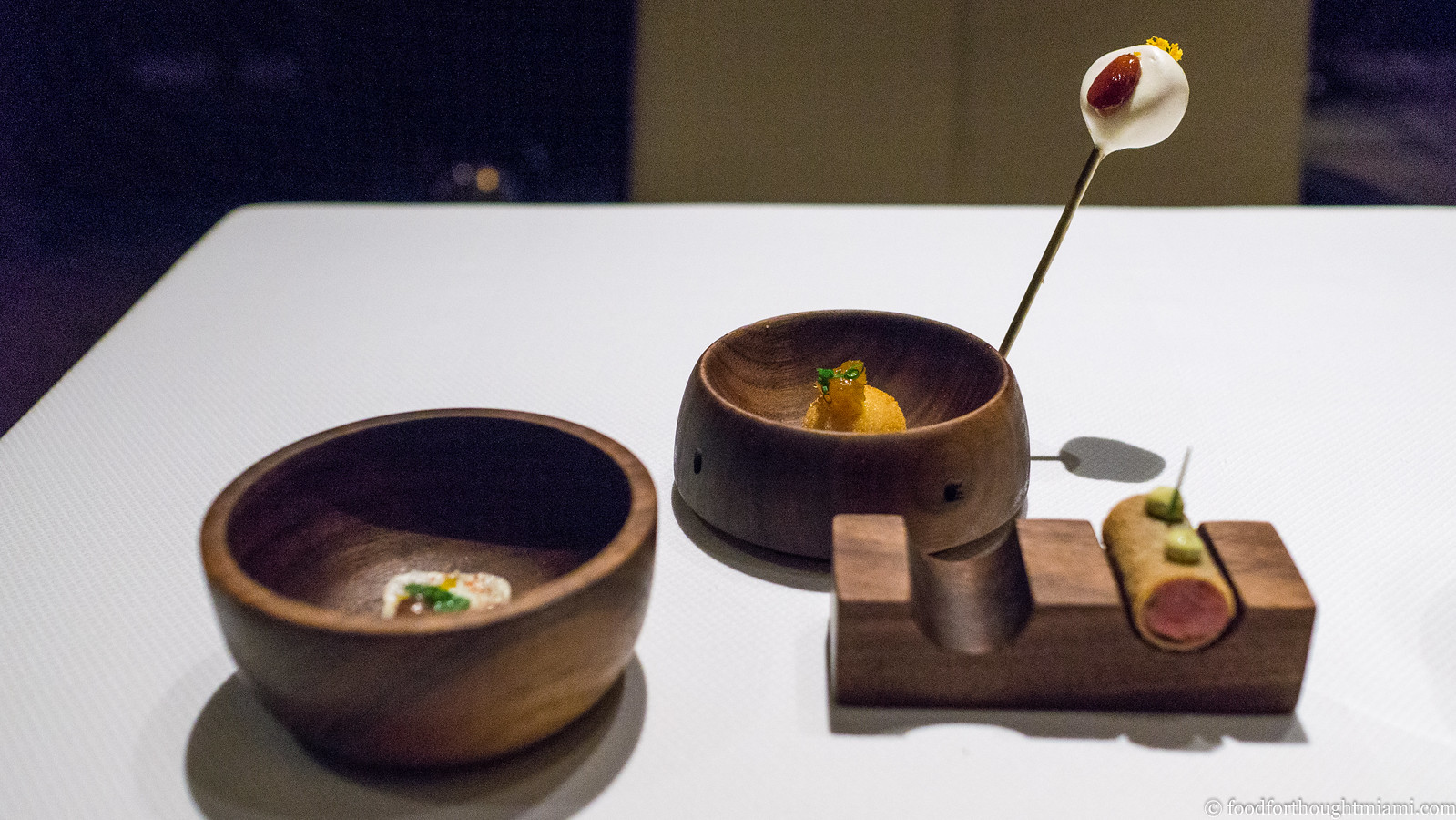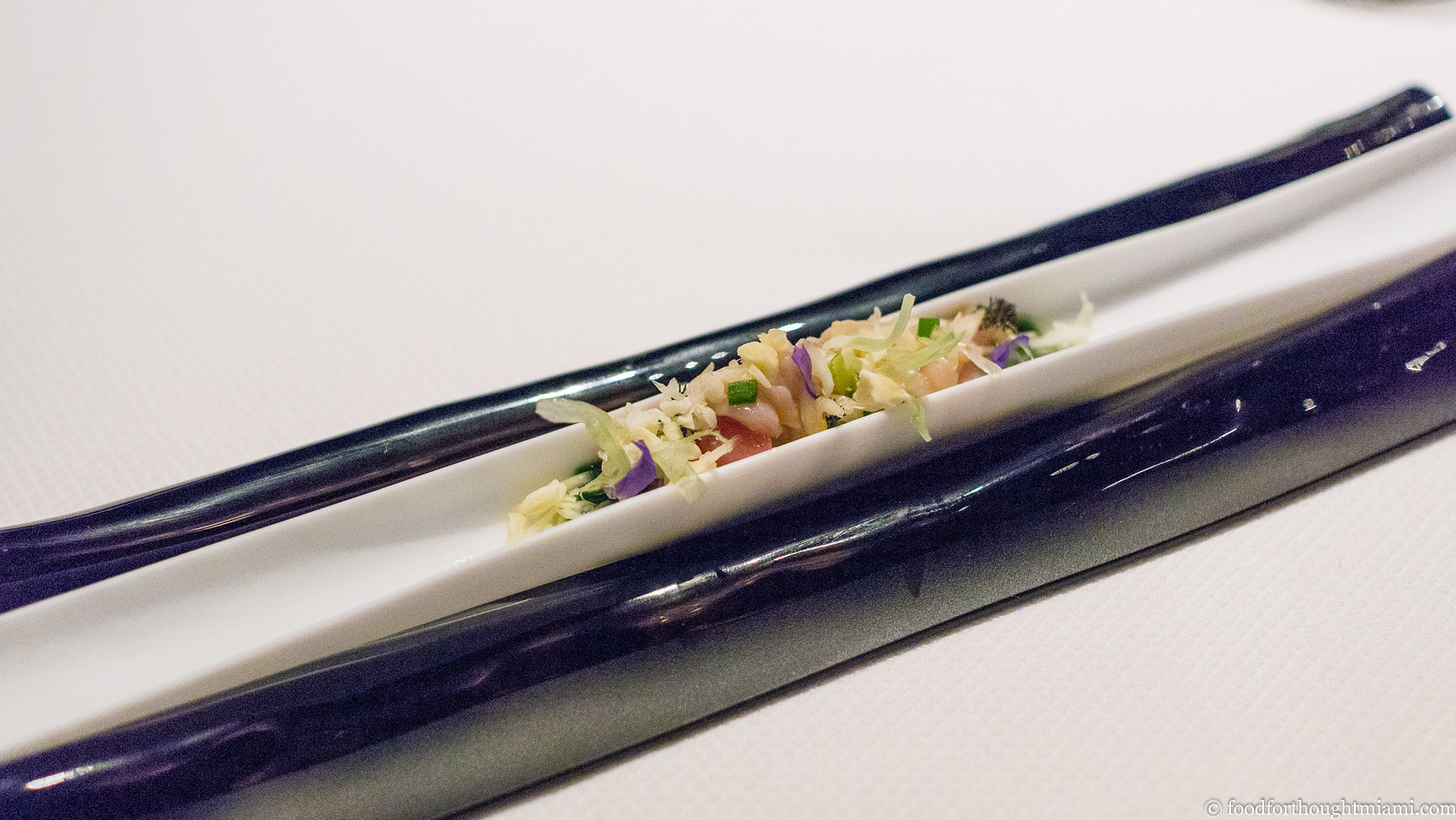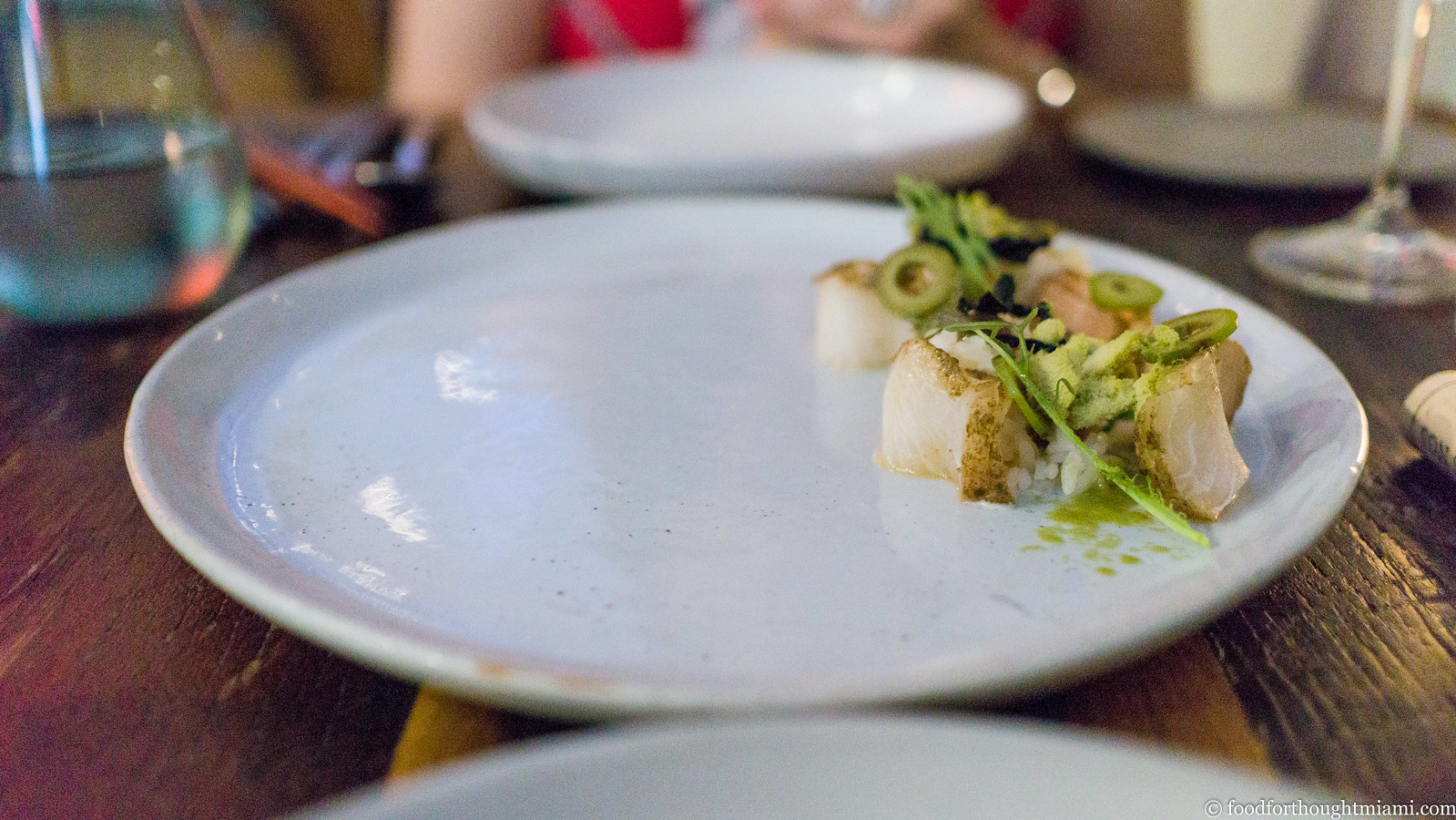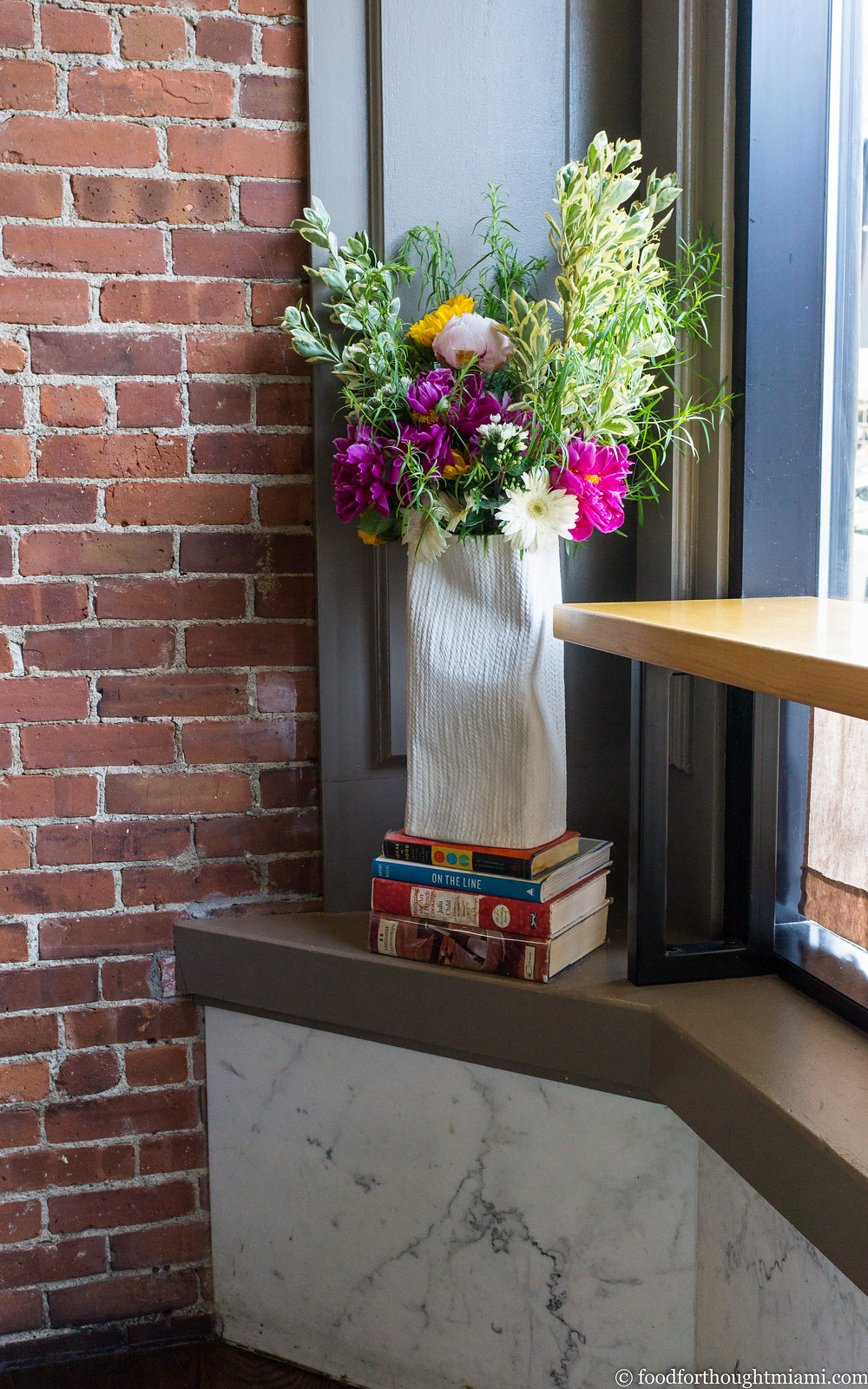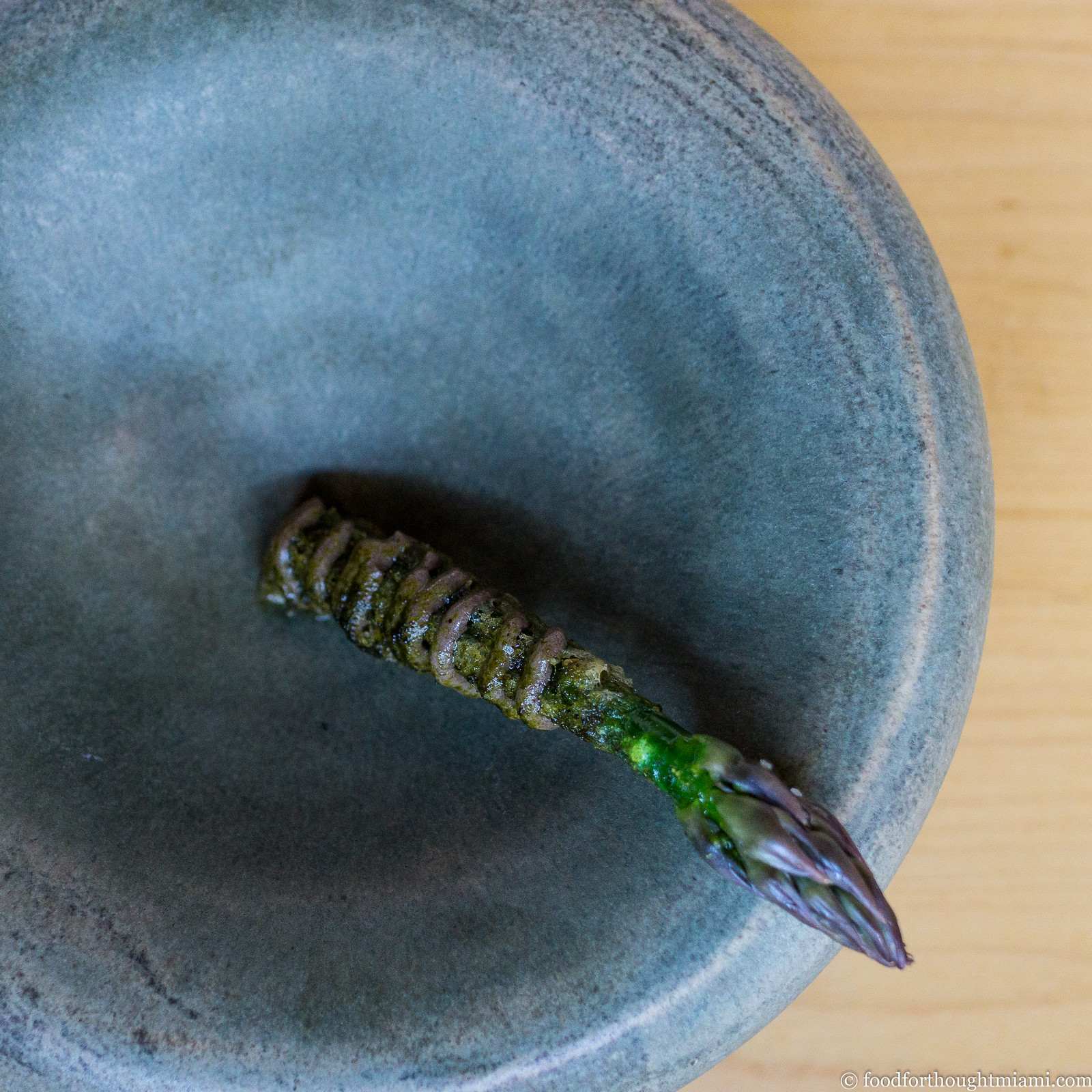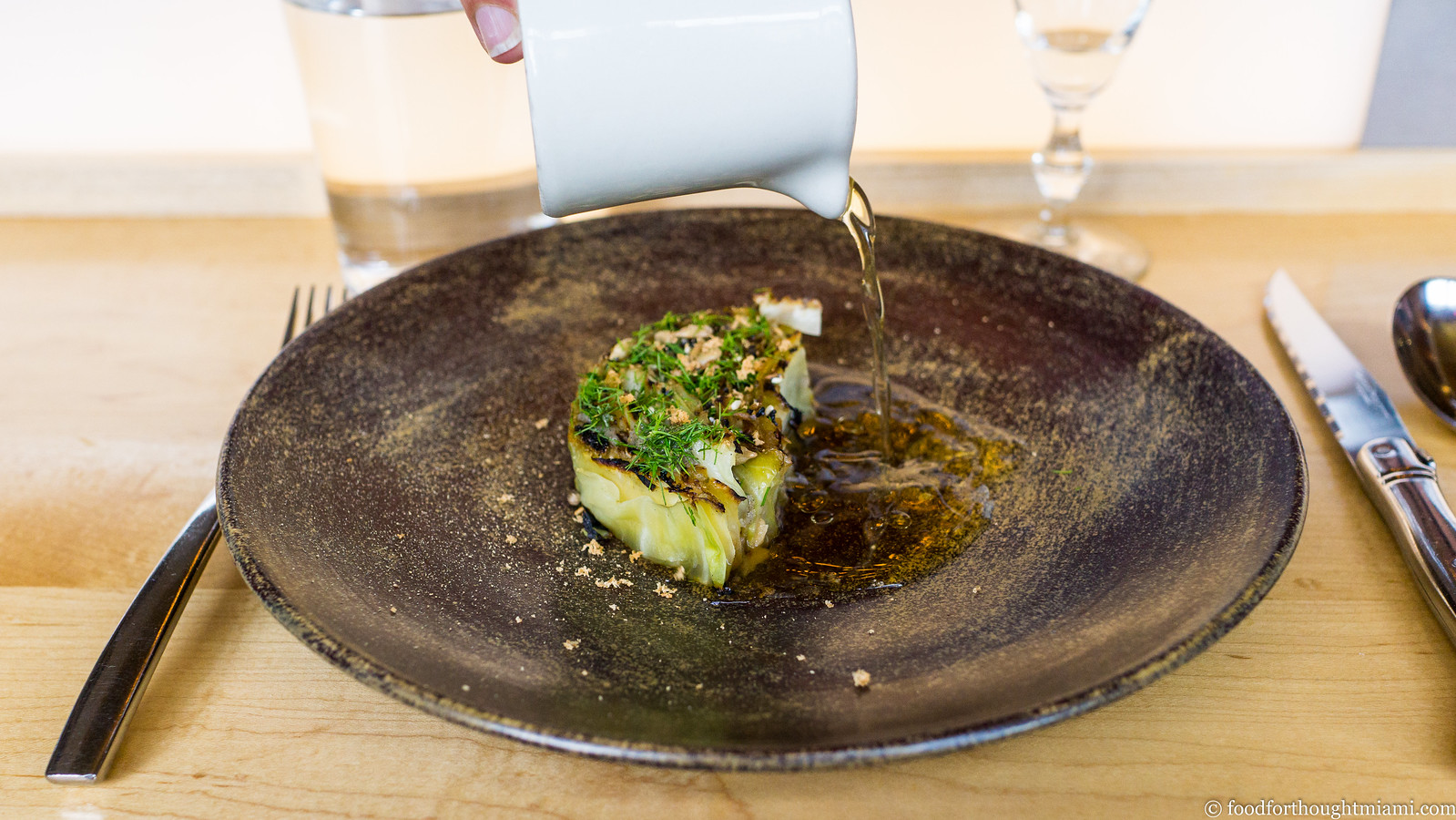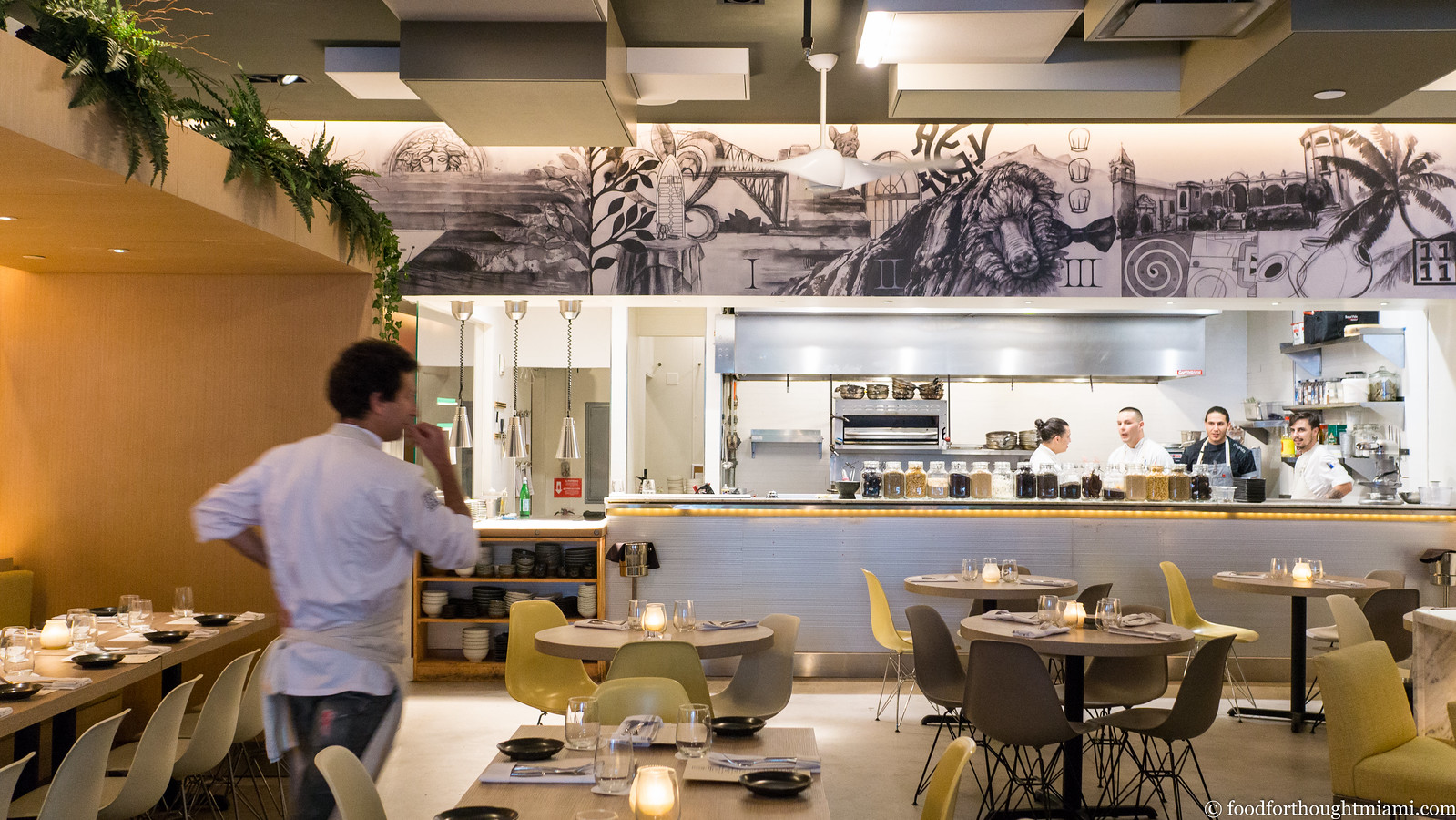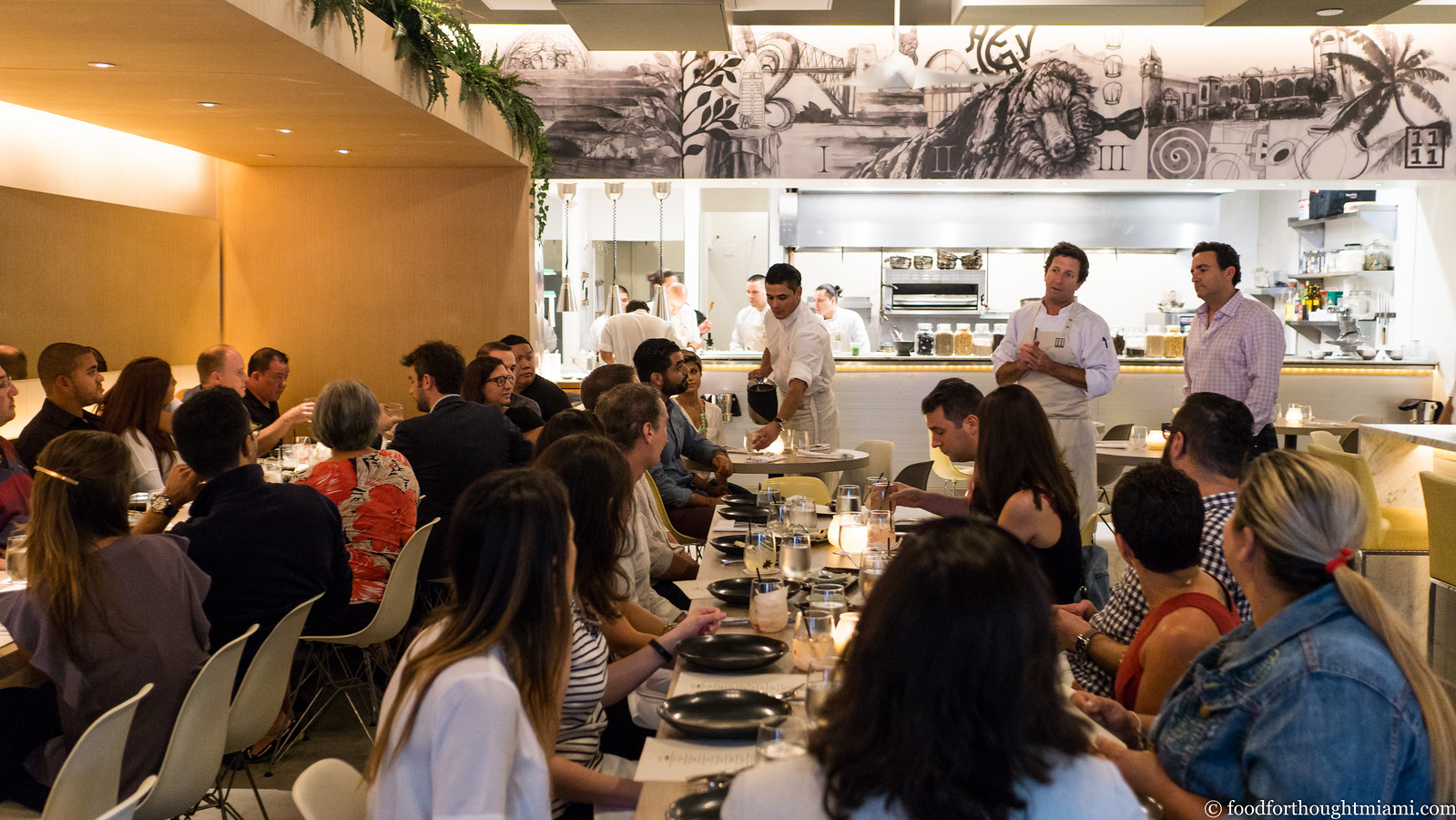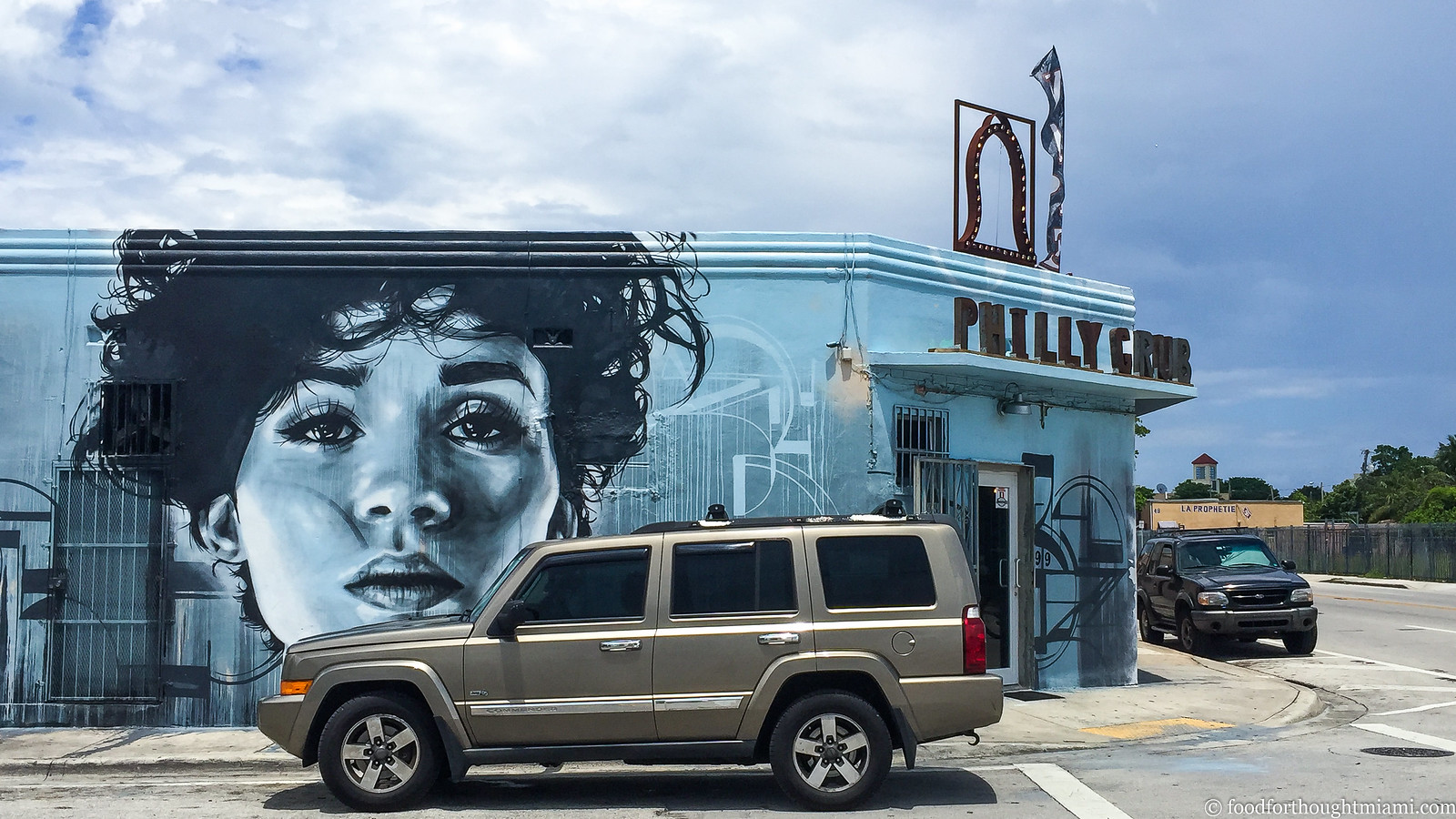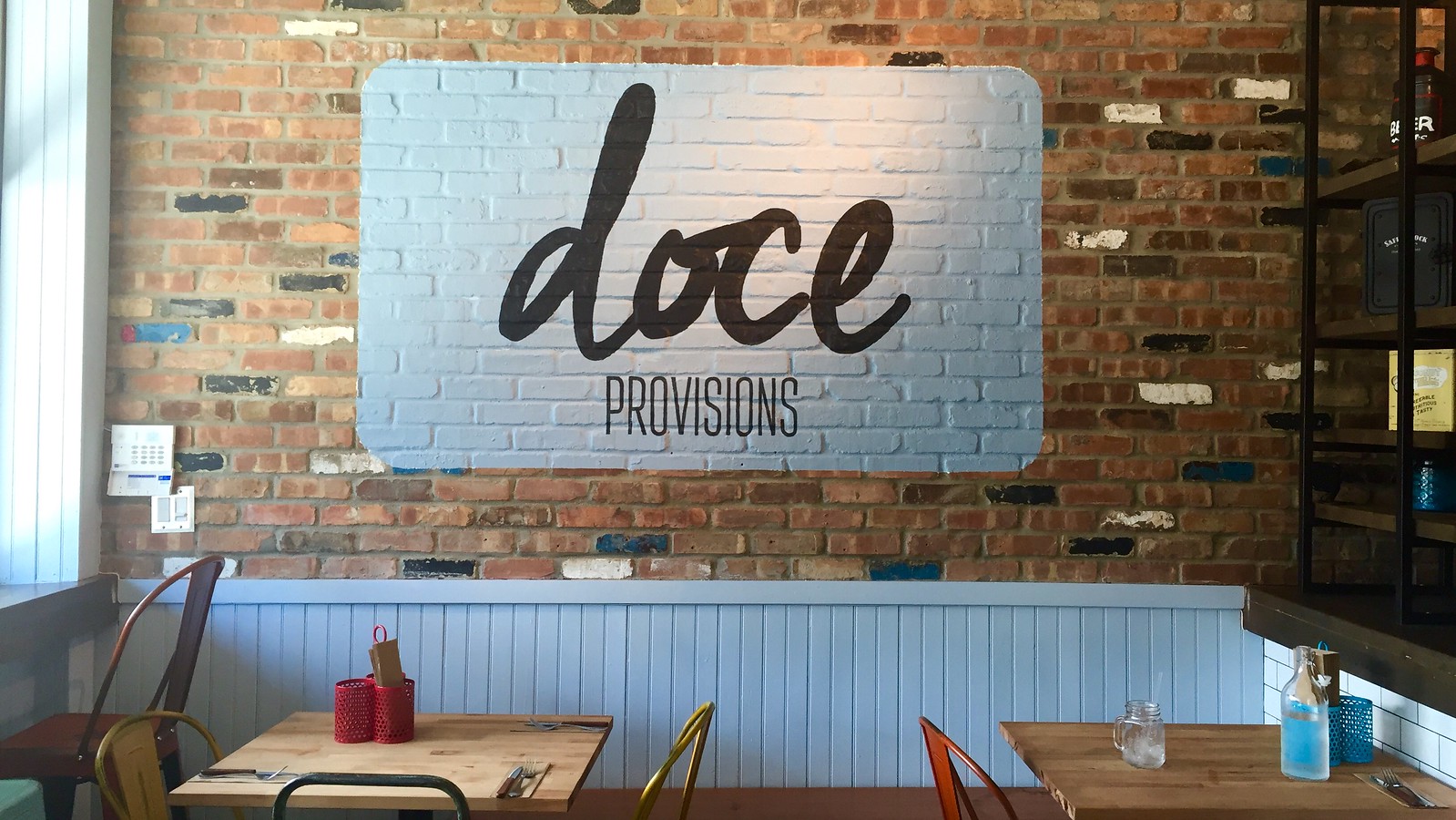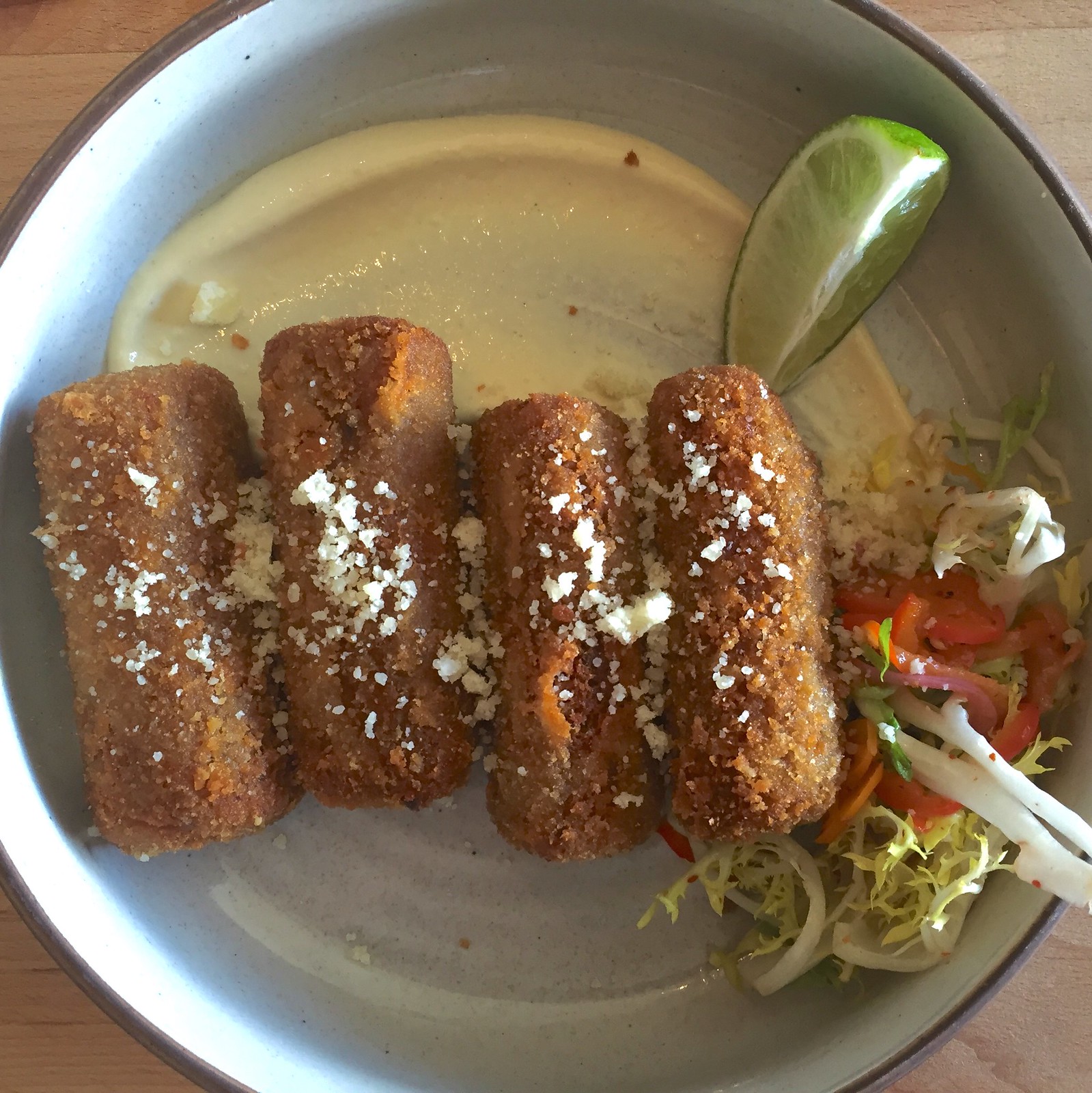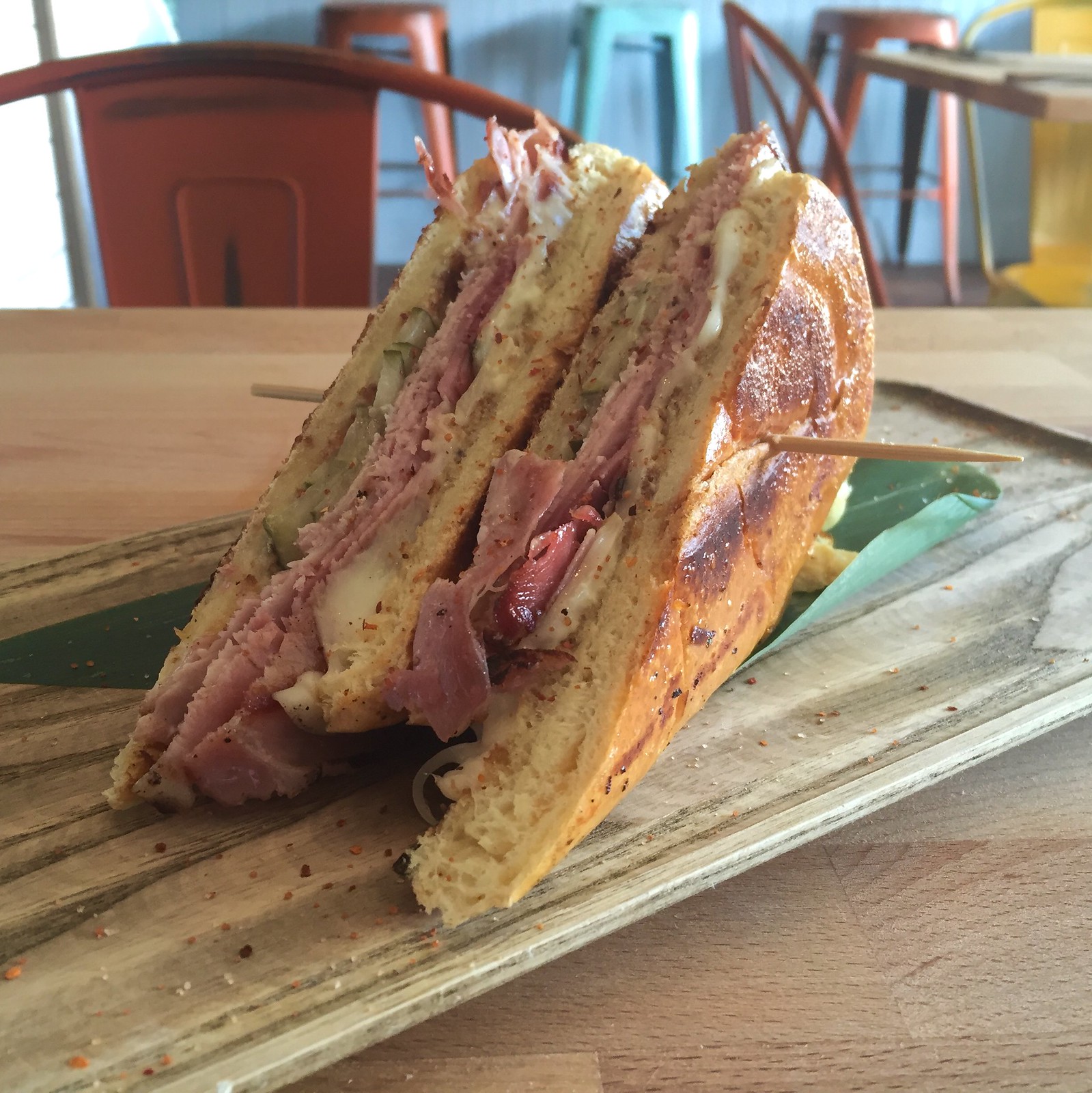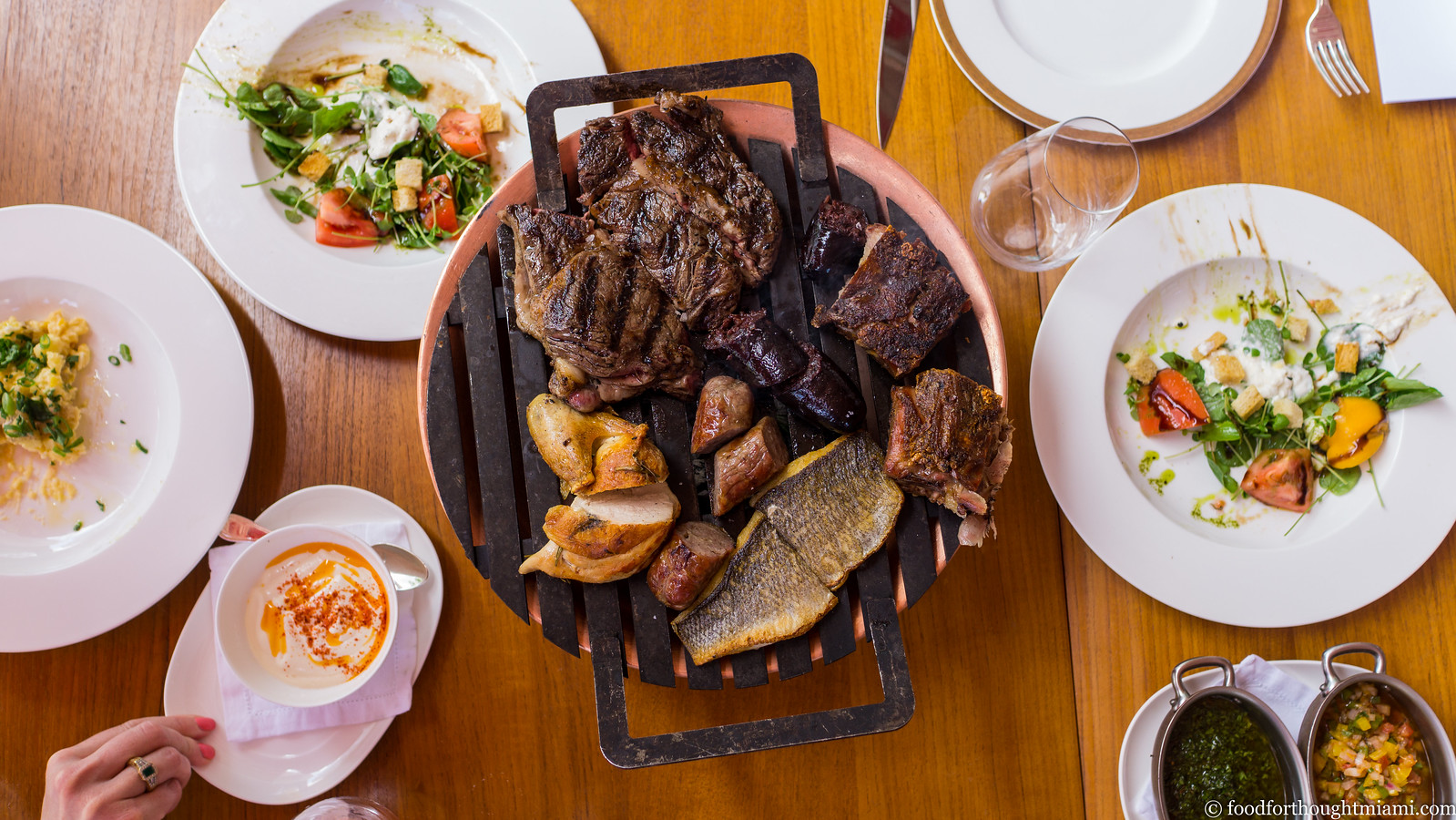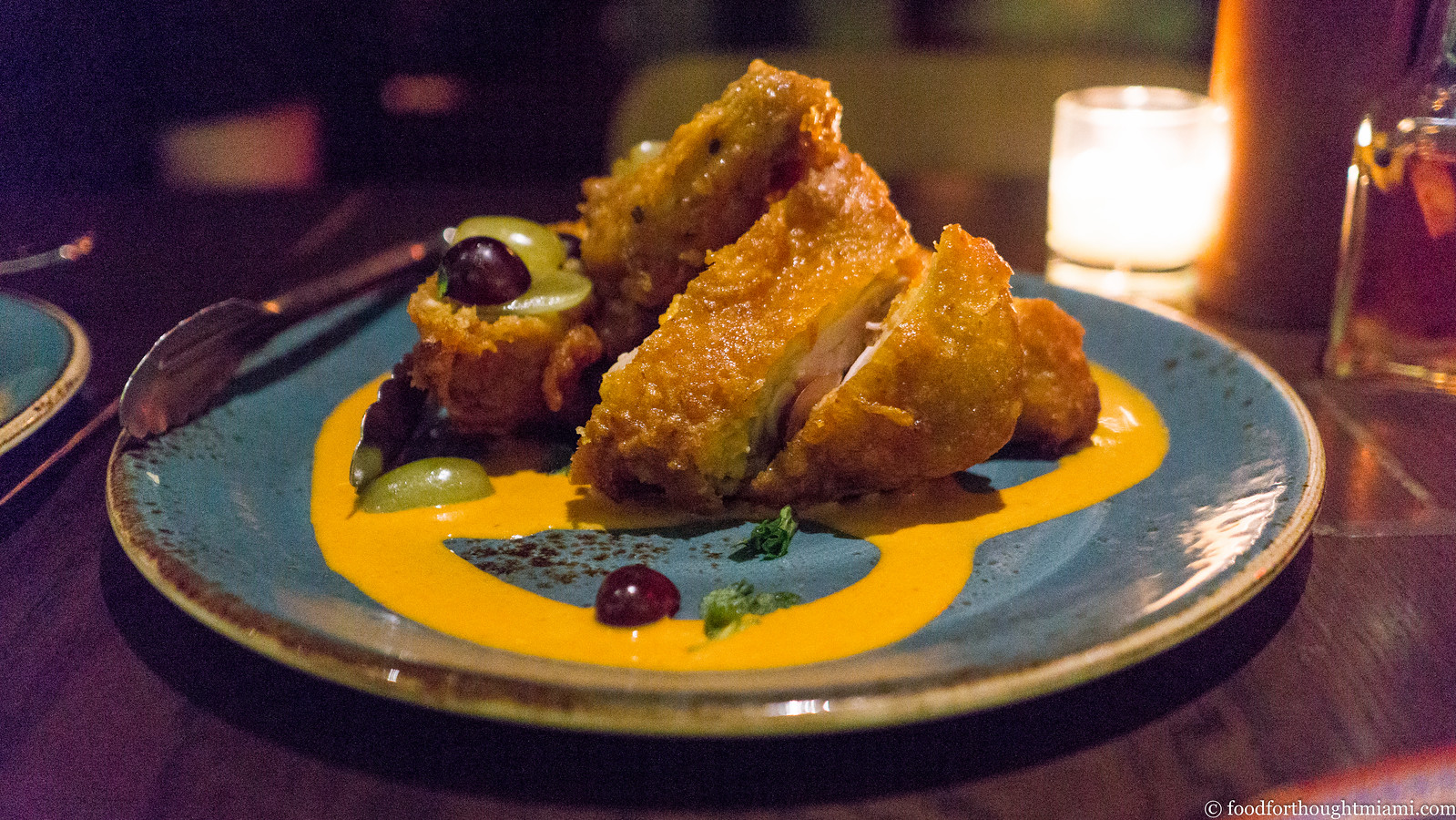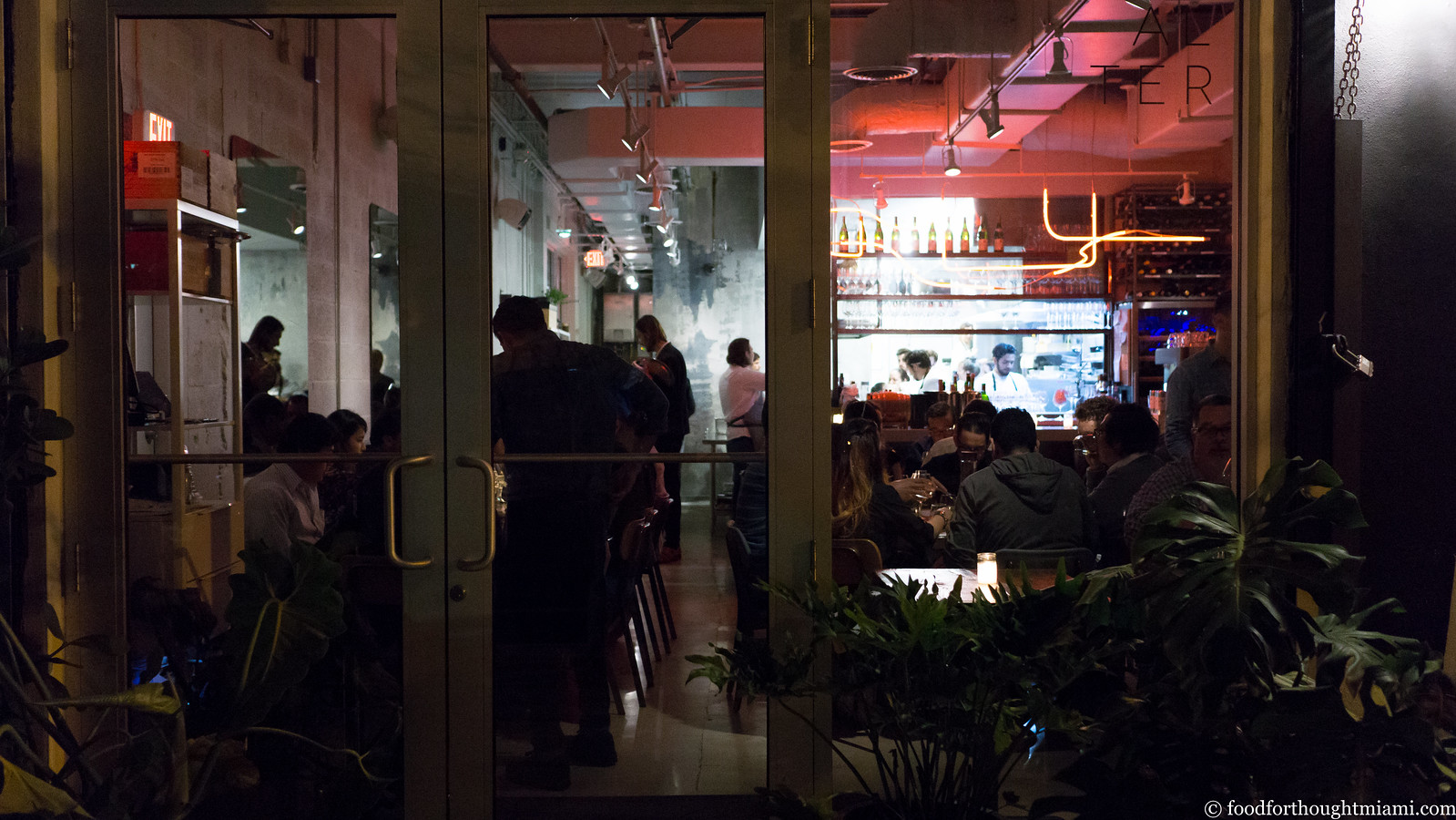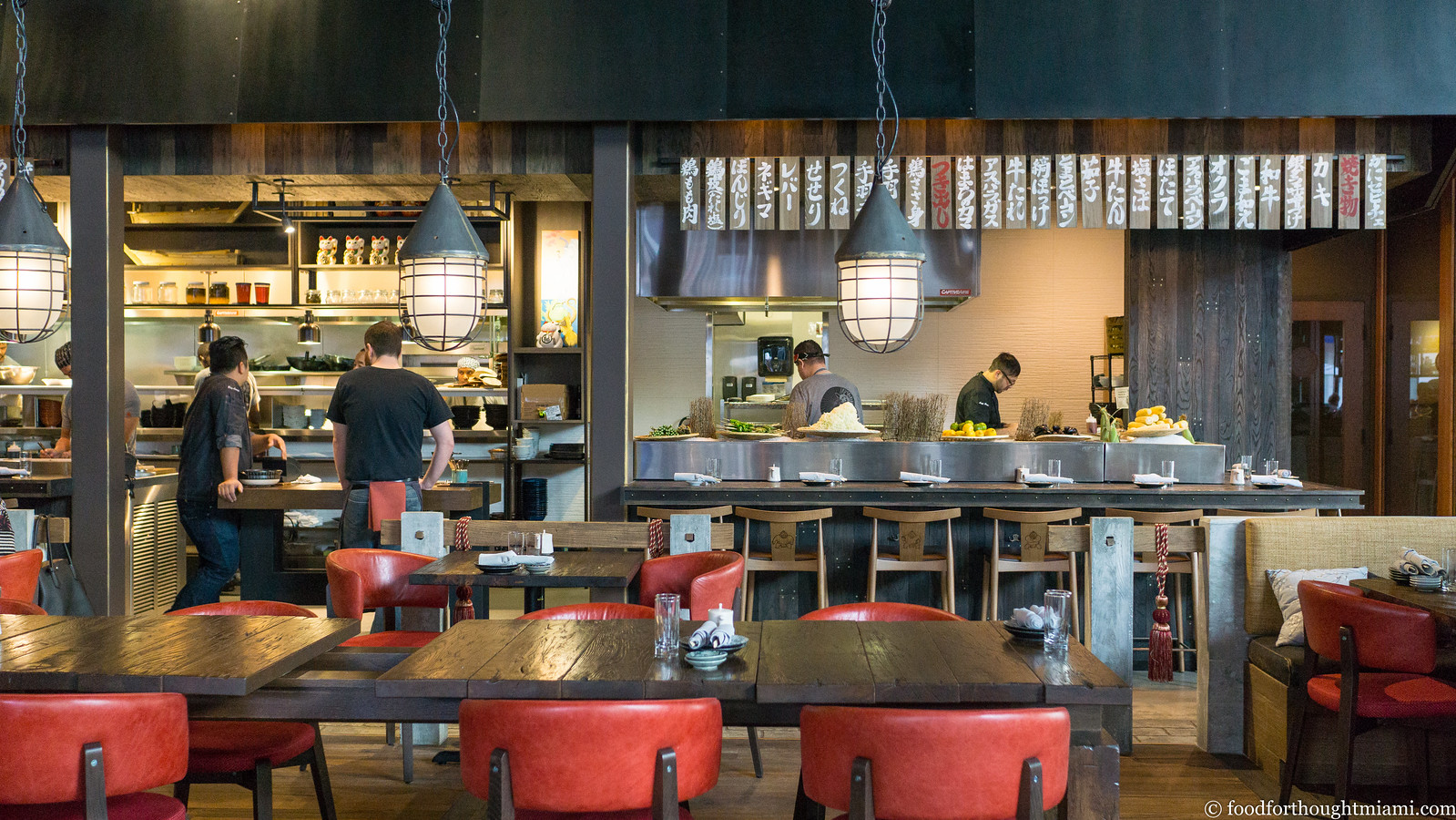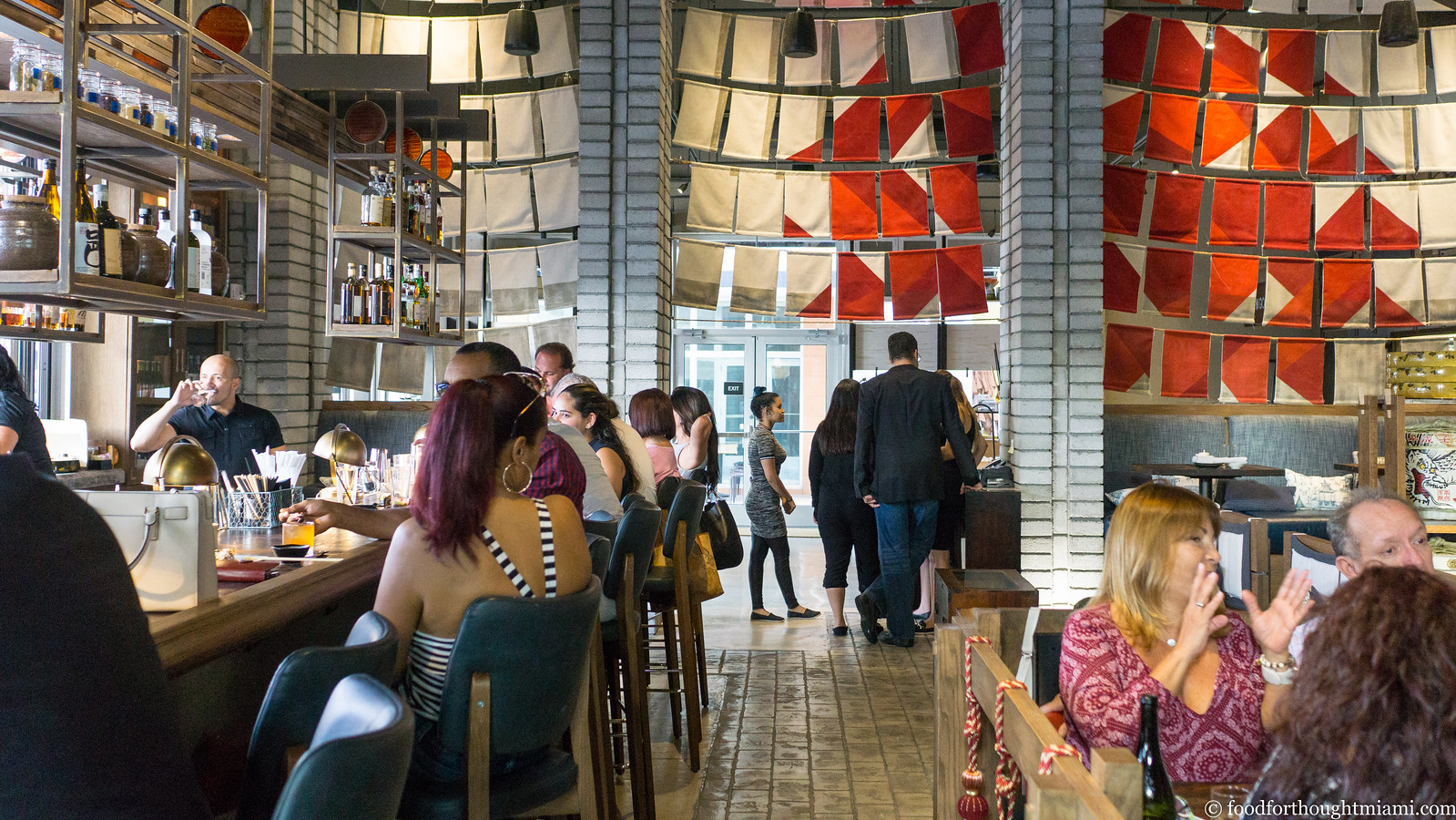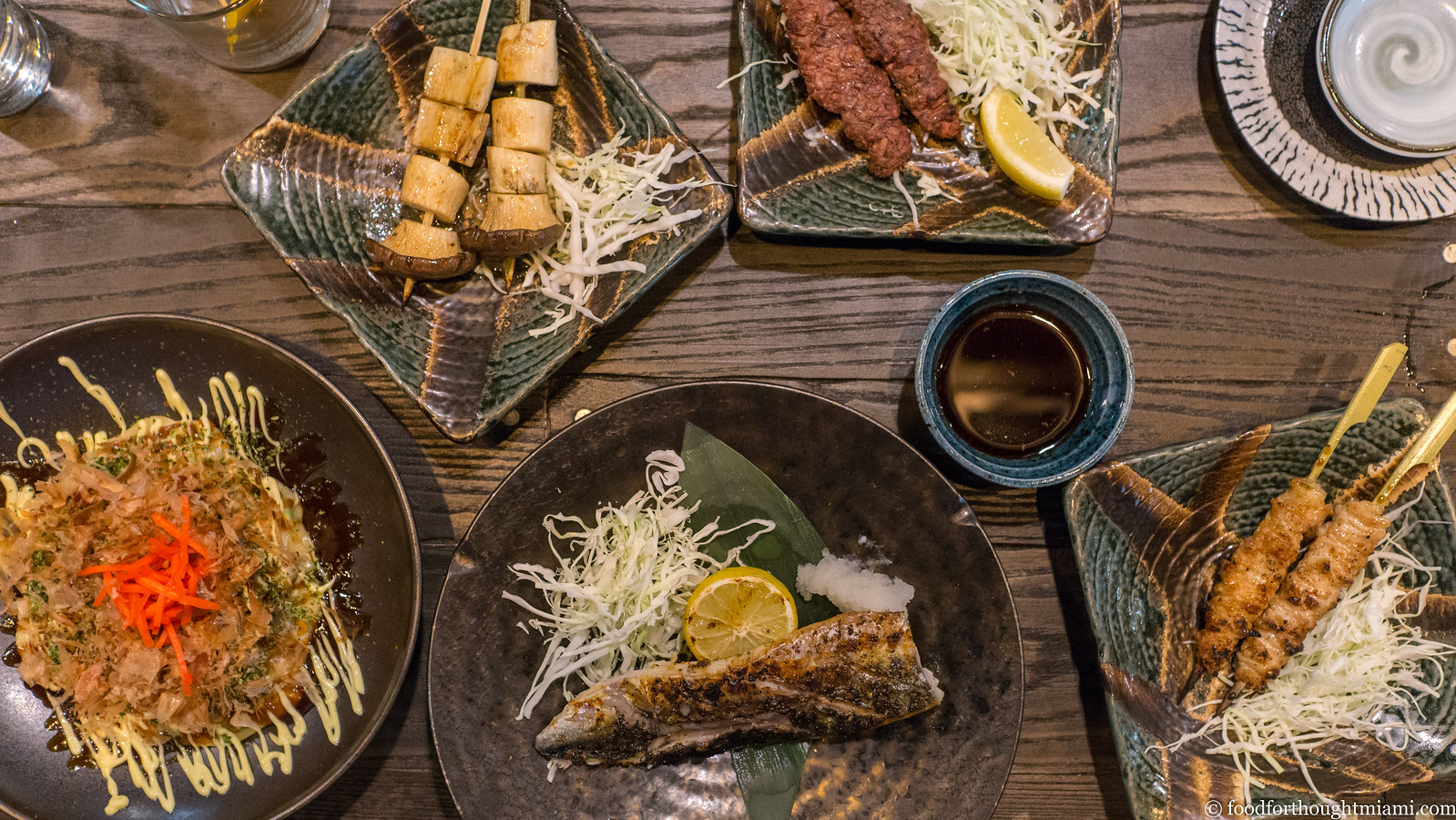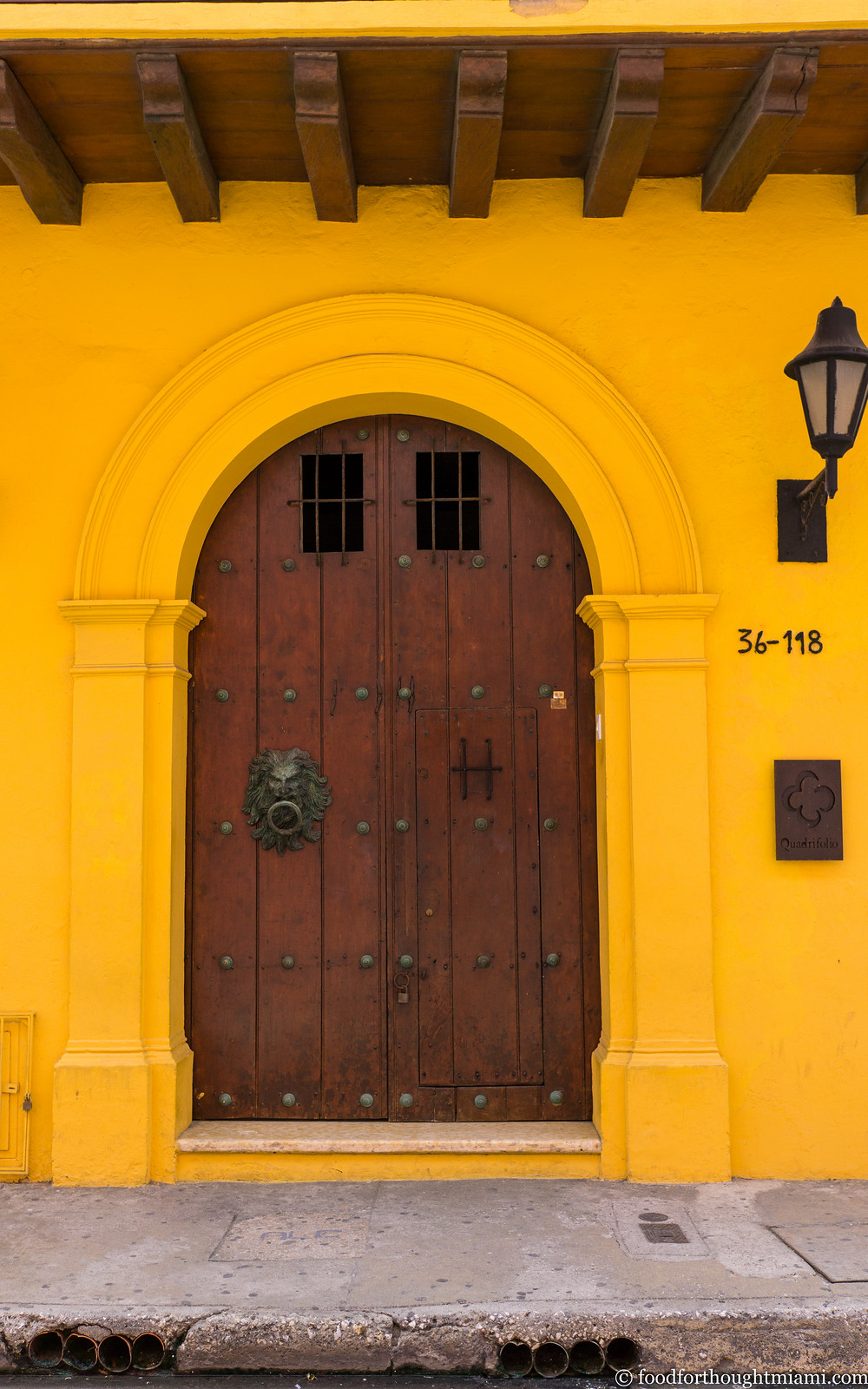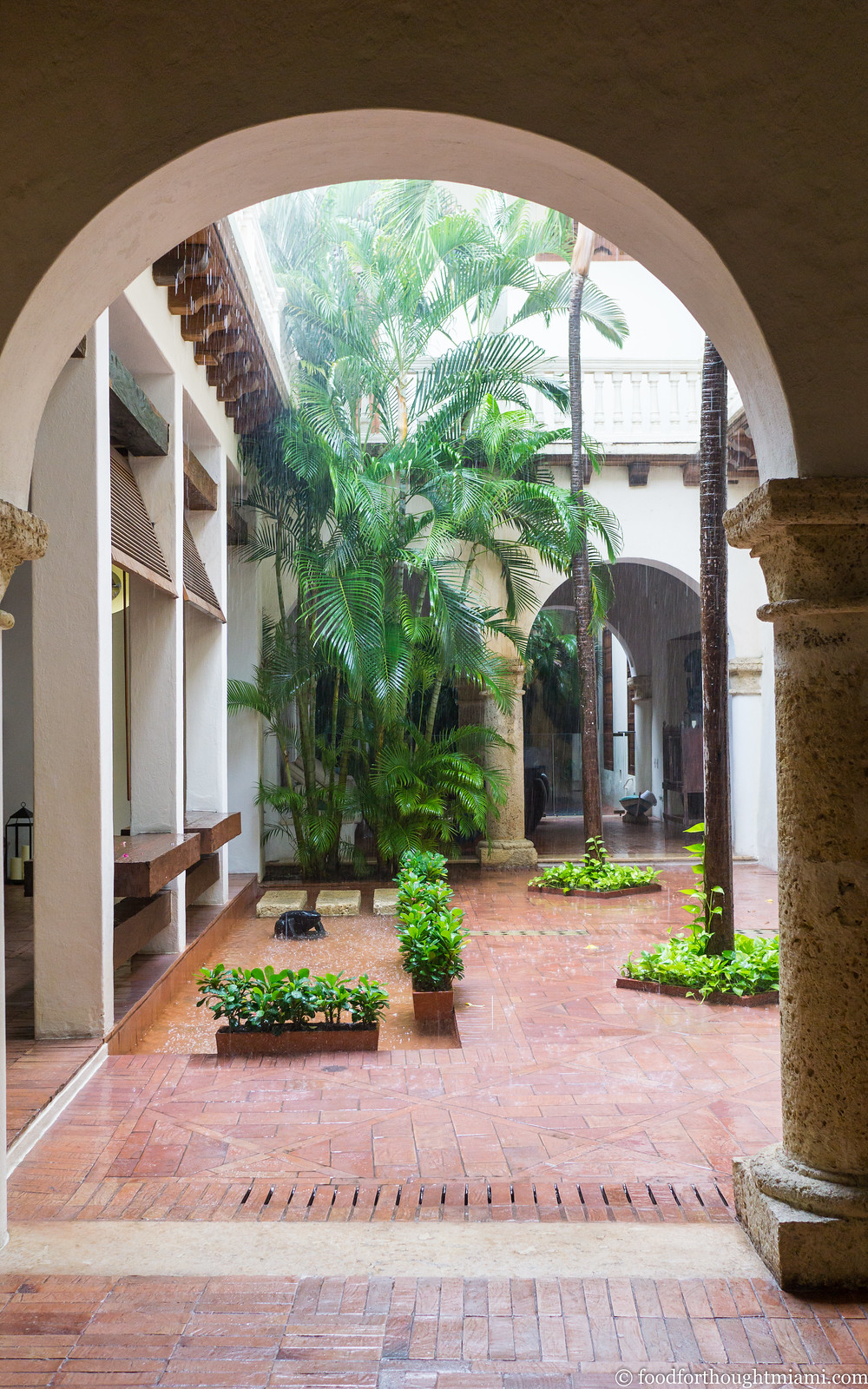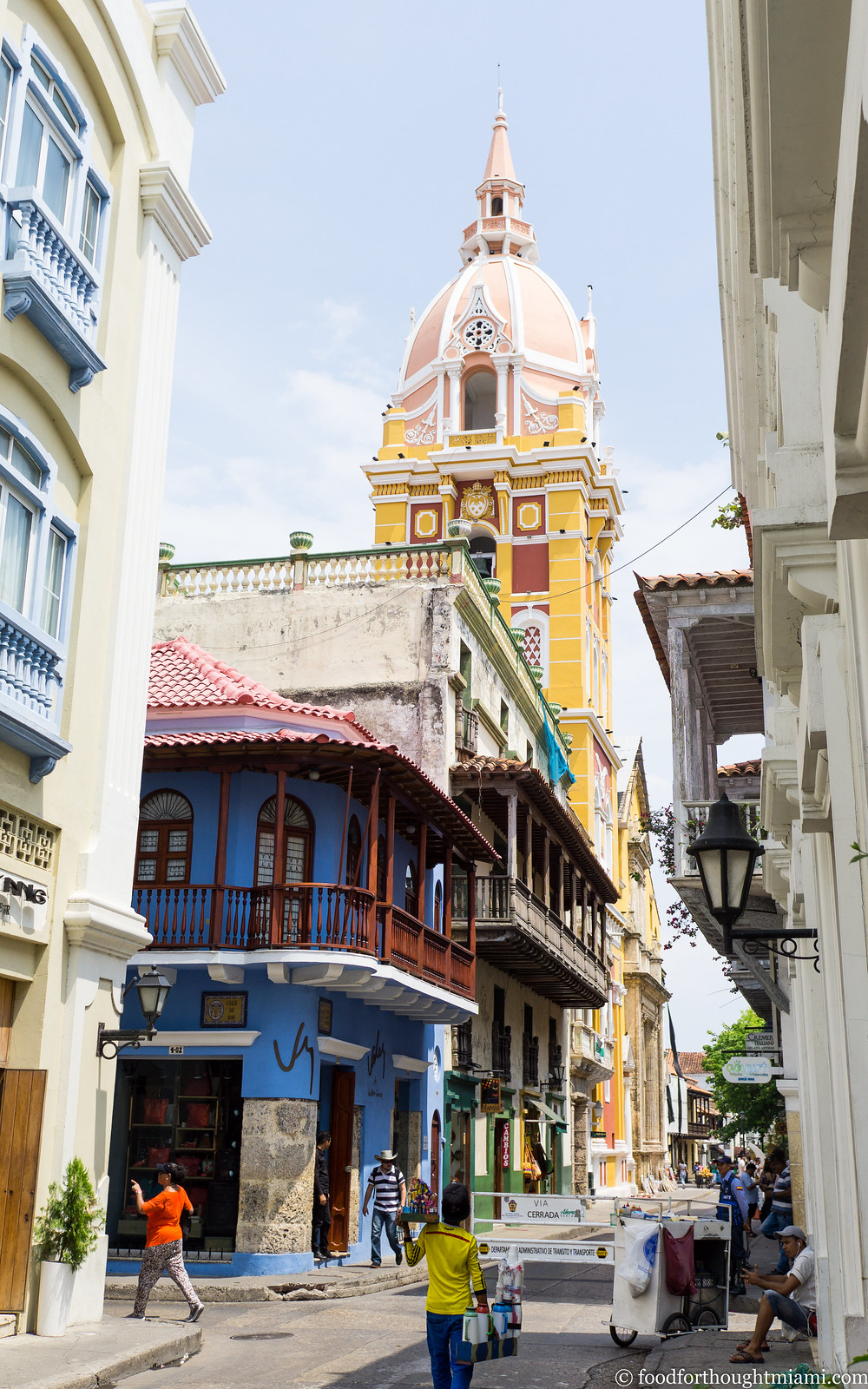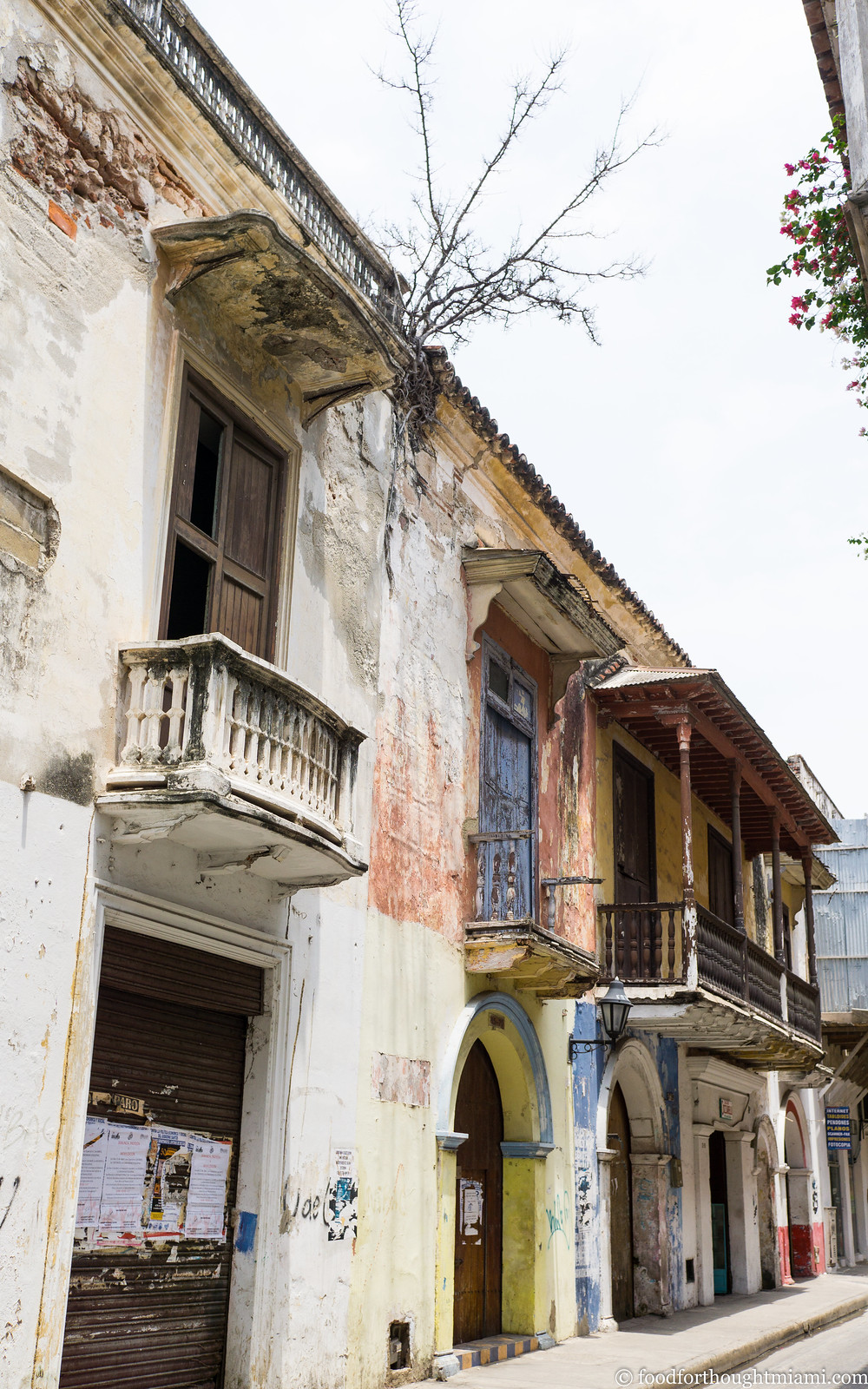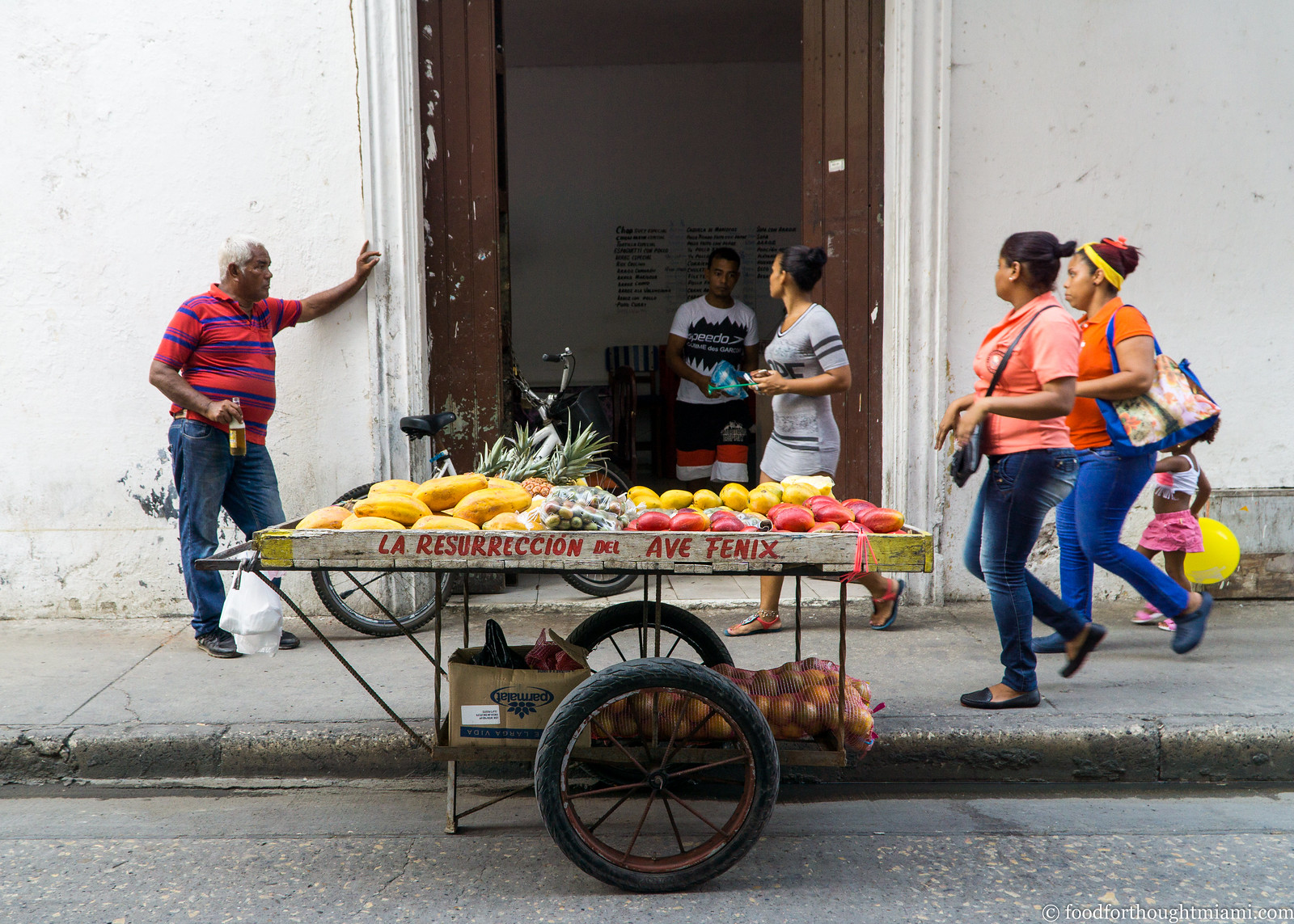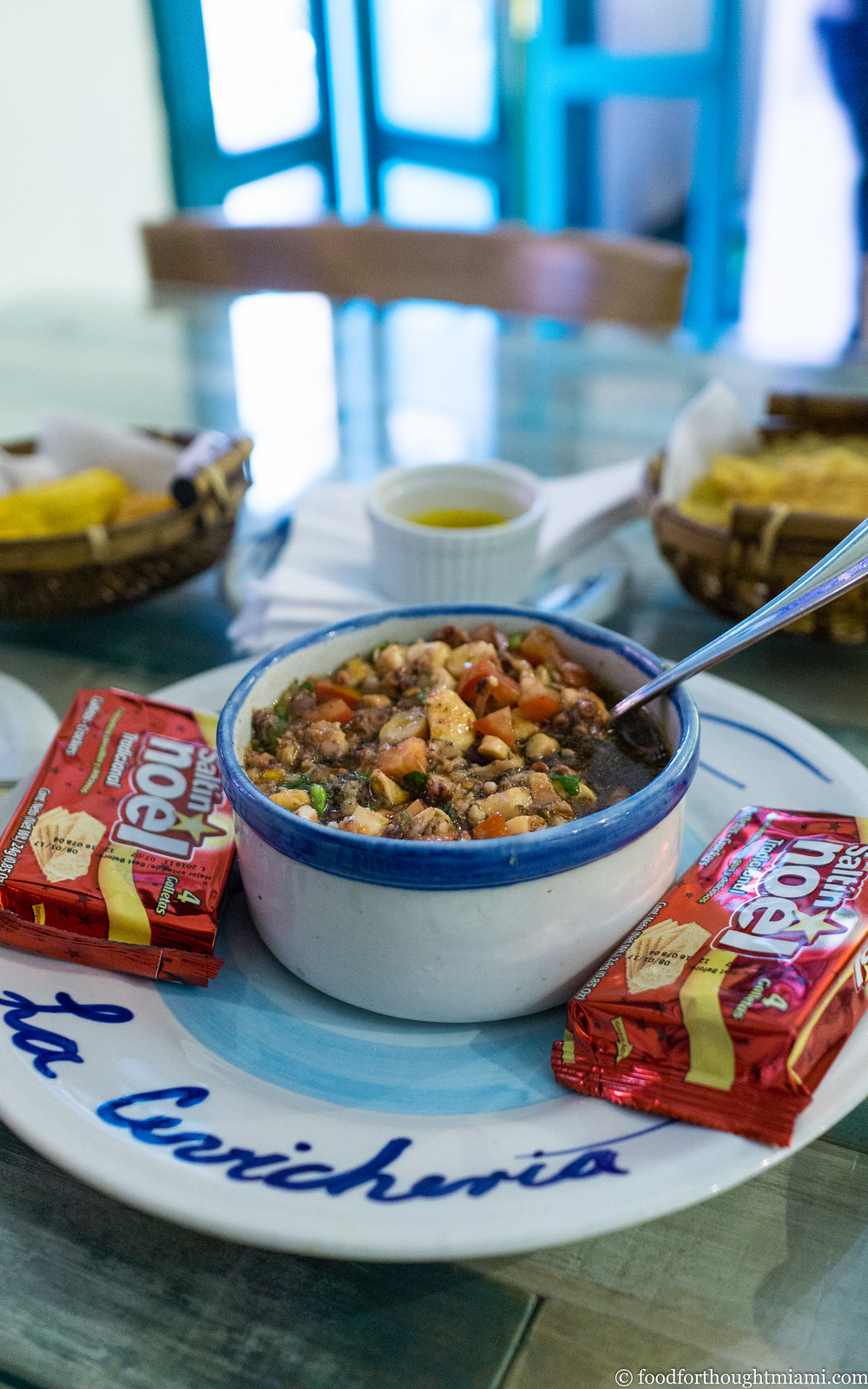Monday, August 8, 2016
best thing i ate last week: orange chocolate souffle at Pinch Kitchen
I'm not much of a dessert person, but there are certain things that hit certain spots for me. The combination of orange and chocolate is one of them, going back to a childhood fondness for the mandarin chocolate sherbet at Baskin Robbins (the flavor was discontinued many years ago, but memories persist). So when I see a dessert with orange and chocolate, I have trouble not ordering it.
Somehow I missed it on my first visit to Pinch Kitchen, a new-ish restaurant opened up on the northern periphery of the "MiMo District" along Biscayne Boulevard by a couple Pubbelly alumni, John Gallo and Rene Reyes. But their short list of desserts includes an orange and chocolate soufflé, baked right inside hollowed out oranges, and served with a classic creme anglaise. I went back for brunch this weekend to try it (and a couple other things).
The soufflé is airy and light but intense with chocolate flavor, drawing some extra citrus perfume as you scrape your spoon across the inside of the orange skin. I don't know if Baskin Robbins is ever bringing back mandarin chocolate sherbet, but this is a good substitute.
Also very good: a wahoo tartare from the daily specials at Pinch, given some tangy brightness from a fine brunoise of fresh peach, and some zing from fresh red chiles.
(There are a few more pictures in this Pinch Kitchen - Miami flickr set).
Pinch Kitchen
8601 Biscayne Boulevard, Miami, Florida
305.631.2018
Monday, August 1, 2016
best thing i ate last week: etouffee brute at Dusk
The last time I was at Cena by Michy (which would, alas, turn out to be the last time I would ever be at Cena, which closed a couple months later), Michelle Bernstein introduced me to her latest chef de cuisine, Mike Mayta. He – and his wife Keily Vazquez, who together also ran Illegal Bakery – were joining a distinguished group of alumni who have passed through Michy's kitchens and dining rooms: Timon Balloo, Lindsay Autry, Jason Schaan, Berenice de Araujo, coctkail master Julio Cabrera, wine savant Allegra Angelo.
Cena is gone, but chefs Mayta and Vazquez have found another place to ply their trade, with a pop-up called Dusk, operating in the Crumb on Parchment space in the Design District (probably not coincidentally, also run by Chef Bernstein). They've put together a menu of a baker's dozen of dishes, some with Latin leanings (ajiaco pot pie, brisket saltado), others a bit more gastropub-y (chicken 'n' biscuit with chicken liver mousse, chorizo scotch egg), and some with a little bit of both (yuca fry poutine).
We made our way through a good bit of that menu Saturday night, and enjoyed everything we tried. My favorite – very possibly influenced by its having been inspired by the Burger of the Day from Bob's Burgers – was the "Etouffee Brute." This Cajun-Italian hybrid combined risotto style carnaroli rice, bound and enriched by a ruddy seafood stew studded with strips of nubby octopus, bolstered and warmed with 'nduja sausage, flecked with slivers of dried okra, and crowned with a plump, juicy head-on royal red shrimp.
A strong runner-up was a summery dessert from Keily Vazquez which combined dainty little blueberry pies with a delicious sweet corn ice cream.
You can see all the pictures from our dinner in this Dusk - Miami Design District flickr set.
Dusk is operating Thursday-Saturday evenings in the Crumb space, from 6pm to 10:30pm, with plans to be there through September.
Dusk
3930 N.E. 2nd Avenue, Miami, Florida
786.292.6799
Wednesday, July 27, 2016
first thoughts: All Day | Downtown Miami
Most of the time, I skip breakfast. I know, they say you're not supposed to, most important meal of the day, blah blah blah – but a cup or two of my inartfully home-brewed coffee first thing in the morning and I'm usually good to go. And yet, I actually love breakfast foods, especially those on the savory side of the aisle: eggs, toast, bacon, sausage – these are all wonderful delicious things. And I'll gladly eat them any time of day.
So I was pretty excited when I heard about All Day, a spot that recently opened in the "Arts & Entertainment District" on the northern edge of downtown Miami. The concept is pretty straightforward: good coffee and egg dishes, served all day. I was even more excited when I learned it was run by Camila Ramos, the talented barista and former head of Panther Coffee's retail operations.
The coffee menu at All Day – posted on the wall in green neon behind a massive Marzocco espresso machine – is a bit enigmatic and designed to foster a conversation. "01 - Double Shot" is straightforward enough, a double shot of straight espresso (pulled with Ruby Coffee Roasters' Creamery Blend; the Panther alumnae is now a free agent and uses beans from several different roasters). But "02 - & Milk" requires some more user input: what's your preferred ratio of milk to coffee, do you like your milk foam wet or dry?
(You can see all my pictures in this All Day - Miami flickr set).
The ten choices also feature drip, pour-over, and cold brew coffees, including a nitrogen gas infused version with the thick, frothy texture of a well-pulled Guinness; esoterica like "Royal Tea" (an infusion of coffee cherry husks and evaporated milk, also given the nitro treatment); and a rotating daily special (currently a concoction of cold brew and rosemary limeade).
I am not really a coffee geek, and won't pretend to be. So I can't tell you much other than that the espresso I had on my first visit was bright and rich and creamy; the "& Milk" I had on my next visit, with a 2:1 espresso:milk ratio (in Miami we'd call this a cortadito; in San Francisco you might call it a "Gibraltar"), was even better. I usually drink my coffee black, but the short pour of milk nicely tempered the acidity of the coffee.
Can we talk about something I actually know something about?
The food menu at All Day, created by chef Charles Lutka, who ran Gigi for the past five years, is very egg-intensive. There are three variations on the theme of breakfast sandwich. The first of these, the "Runny & Everything," combines a sunny-side-up fried egg with a couple slices of bacon, sharp cheddar cheese, lettuce, and a thick slab of tomato, all served on a puffy, everything-spice dusted brioche bun. Though nominally a sandwich, this is – as the name warns – a gooey, fork and knife affair. It was a good combination; I think a sturdier bread might give it a little more architectural integrity, something more up to the task of sopping up that runny yolk.
The Pan Con Croqueta was another tasty combination that I wound up giving the Costanza treatment. A variation on a Cuban breakfast staple, this sandwich was anchored by a couple plump, crisp-edged pork croquetas, resting atop a runny, green-hued, herb-flecked egg spread, with some gouda cheese for a little extra creaminess and thin-sliced pickles for some tart contrast. Even the sturdier Cuban bread couldn't quite hold together the runny egg salad, though this was another delightfully happy mess. I suppose if I want to keep my hands clean, I should try the "One Handed" next.
(continued ...)
Sunday, July 17, 2016
Cobaya Qui at Pao
Every time we do one of these Cobaya dinners, there are always any number of things which can go wrong. We ask the chefs to push themselves, to truly treat it as an experiment; and not every experiment succeeds. We encourage ambition, even when sometimes the reach may exceed the grasp. A dish just may not work, or the execution may falter when the scale goes from a test run in the kitchen to a service for a big group.
Then every so often we miss in the opposite direction, and fail to instill the trust or confidence that emboldens a chef to go outside of their comfort zone.[1] Even a very good meal can be something of a disappointment – for us, anyway – if it doesn't offer something different from the usual restaurant experience.
I'd been to Paul Qui's restaurant Pao in the Faena Miami Beach once before, very shortly after it opened (and wrote about it here, where you can also get much of Chef Qui's back story). I had a good meal – some dishes were great – but it felt restrained, like there was a lot more reverberating under the surface. It almost seemed as if he was cooking for this room, trying to match the polish of the gilded (literally!) ceiling and multi-million dollar Damien Hirst sculpture that is its centerpiece. I wanted to see what he could do if unburdened by those expectations, and just allowed to cook.
Qui and his chef de cuisine at Pao, Derek Salkin, did exactly that this past Thursday for fifty of us guinea pigs. And this one got pretty much everything right.
(You can see all my pictures in this Cobaya Qui at Pao flickr set).
After a welcome cocktail, a variation on a blackberry bramble, which some enjoyed on the terrace, we settled into several communal tables to start dinner.
A couple small bites to start: first, kumamoto oysters, topped with sake granite, in a frothy puddle with flavors of shiso, umeboshi and tomato. Next, upright lumpia, their crisp shells filled with foie gras, tangy, floral passionfruit, szechuan peppercorn for zing, crumbled pistachio for nutty depth.
This first full course was an unusual one, but I liked how it all pulled together. The base of the plate was covered with a film of slippery, silky rice milk, dotted with olive oil, an herbaceous green purée, and flower petals. That was the platform for a scoop of creamy, milky fresh ricotta, laden with shiny smoked trout roe and ribbons of white kimchi, the fermented cabbage adding some kick and contrast. A twisted black garlic cracker topped the odd but tasty composition.
(continued ...)
Then every so often we miss in the opposite direction, and fail to instill the trust or confidence that emboldens a chef to go outside of their comfort zone.[1] Even a very good meal can be something of a disappointment – for us, anyway – if it doesn't offer something different from the usual restaurant experience.
I'd been to Paul Qui's restaurant Pao in the Faena Miami Beach once before, very shortly after it opened (and wrote about it here, where you can also get much of Chef Qui's back story). I had a good meal – some dishes were great – but it felt restrained, like there was a lot more reverberating under the surface. It almost seemed as if he was cooking for this room, trying to match the polish of the gilded (literally!) ceiling and multi-million dollar Damien Hirst sculpture that is its centerpiece. I wanted to see what he could do if unburdened by those expectations, and just allowed to cook.
Qui and his chef de cuisine at Pao, Derek Salkin, did exactly that this past Thursday for fifty of us guinea pigs. And this one got pretty much everything right.
(You can see all my pictures in this Cobaya Qui at Pao flickr set).
After a welcome cocktail, a variation on a blackberry bramble, which some enjoyed on the terrace, we settled into several communal tables to start dinner.
A couple small bites to start: first, kumamoto oysters, topped with sake granite, in a frothy puddle with flavors of shiso, umeboshi and tomato. Next, upright lumpia, their crisp shells filled with foie gras, tangy, floral passionfruit, szechuan peppercorn for zing, crumbled pistachio for nutty depth.
This first full course was an unusual one, but I liked how it all pulled together. The base of the plate was covered with a film of slippery, silky rice milk, dotted with olive oil, an herbaceous green purée, and flower petals. That was the platform for a scoop of creamy, milky fresh ricotta, laden with shiny smoked trout roe and ribbons of white kimchi, the fermented cabbage adding some kick and contrast. A twisted black garlic cracker topped the odd but tasty composition.
(continued ...)
Monday, July 11, 2016
best thing i ate last week: hokkaido uni at Shuko (New York City)
Some sort of sound had involuntarily come out of my mouth. I'm not sure exactly what it was; it may have been a moan. It may have been a giddy chuckle. But when I came back to my senses, I saw that everyone on the other side of the counter was looking at me with an expression somewhere between bemusement and shock.
Shuko is not a stereotypically austere, somber sushi bar: the soundtrack is dominated by old-school hip-hop, and the chefs fist-bump regulars across the bar. But still, whatever I'd done had caught everyone's attention.
It was triggered by this bite of Hokkaido uni: the lobes of sea urchin cold and creamy, with a flavor both briny and fruity, like an oceanic peach, tucked over a pillow of rice into a gunkan maki of crisp nori. Beautiful stuff, worth embarrassing yourself a little bit.
You can see all the pictures from our omakase dinner at Shuko in this Shuko - New York City flickr set.
Shuko
47 E. 12th Street, New York, NY
212.228.6088
Shuko is not a stereotypically austere, somber sushi bar: the soundtrack is dominated by old-school hip-hop, and the chefs fist-bump regulars across the bar. But still, whatever I'd done had caught everyone's attention.
It was triggered by this bite of Hokkaido uni: the lobes of sea urchin cold and creamy, with a flavor both briny and fruity, like an oceanic peach, tucked over a pillow of rice into a gunkan maki of crisp nori. Beautiful stuff, worth embarrassing yourself a little bit.
You can see all the pictures from our omakase dinner at Shuko in this Shuko - New York City flickr set.
Shuko
47 E. 12th Street, New York, NY
212.228.6088
Friday, July 1, 2016
Quince Restaurant | San Francisco
Quince Restaurant is something of an anachronism. In these days of bare tables and and backless stools and leather-aproned servers, here there are still white linens and cushions and tailored suits. Refinement. Elegance.
I wasn't so sure I cared about such things so much any more, but a solo meal there a few months ago left me feeling happily coddled like a soft, warm, perfectly cooked egg. It's not just the trappings, it's the entire gestalt of the place: you don't feel so much like a customer as the guest of a wealthy, thoughtful friend. If fine dining is dead, Quince never got around to reading the obituary.
I was basically killing time before a red-eye flight home from San Francisco, and Quince might not have been on my radar but for several people mentioning it when I went fishing for suggestions on twitter. Then I recalled that on our last visit to San Francisco, we'd stayed just up the street from its more casual sibling, Cotogna, right in the path of a cloud of intoxicating aromas which emanated from the kitchen every afternoon. So I'd booked an early reservation, and now settled into a banquette (one of the joys of solo dining is getting to sit in the comfy seat) and watched as the room slowly filled. A cut crystal coupe was also filled with champagne, as an assortment of amuse-bouches was brought to the table.
(You can see all my pictures in this Quince Restaurant flickr set).
A finely minced steak tartare wrapped within a cylinder of bric pastry, dabbed with a tart gribiche sauce; a bon-bon of pickled persimmon with marcona almonds; a delicate croqueta of jamón ibérico dabbed with sweet onion jam; a featherweight chicharrón cracker, with a delightful crackle.
There was a stretch of a few months where every tasting menu I tried started with an oyster. If it's a good oyster, I'm OK with that. This one – from Fanny Bay in British Columbia – was a good one, its fluted shell also bearing some little horseradish pearls, a pink peppercorn mignonette and tiny tarragon leaves (a great accent mark over the cucumber-y flavor of the oyster).
Light and delicate, this little salad of empire clam[1] with purple borage flowers, fennel and meyer lemon, all nestled over a bright green borage leaf purée, arrived in a long, skinny dish reminiscent of a razor clam shell. For an eating utensil, they provided the same item with which it was plated: tweezers.
Clearly, Chef Michael Tusk likes caviar. If you're not up for a full tasting menu, Quince has a salon where you can order several items a la carte, including an entire menu devoted to caviar selections. In the dining room, it was served two ways: on one side, a ring of tender brioche adorned with generous quenelles of Tsar Nicolai reserve caviar, buttons of creme fraiche and vibrant flower petals; on the other, a bed of creamy sea urchin, topped with an even more generous spoonful of steely grey roe, with a fine julienne of fennel and apple which provided a beautiful lift and brightness to the dish.
(continued ...)
Tuesday, June 28, 2016
best thing i ate last week: shaved cobia at Alter
It had been about six months since I'd been to Alter for a regular dinner, though in the interim, I'd attended a few excellent collaborative dinners there with chefs from Contra, Central and Aubergine. Also in the interim, Alter's chef, Brad Kilgore, was named a "Best New Chef" by Food & Wine magazine, and Kilgore and Alter were selected as semi-finalists in the James Beard Foundation Rising Star and Best New Restaurant categories, respectively (both national, rather than regional, recognitions). Not a bad stretch. And fully deserved, for what is currently my favorite restaurant in Miami.
More good news since my last regular visit: the dinner menu is almost entirely new, with only a few staples remaining (the grouper cheek, the short rib in a somewhat modified form, and of course the soft egg with scallop mousse and the bread and beurre). So Mrs. F and I were able to construct a DIY tasting menu of almost entirely new dishes (it's tough to pass up that egg).
I liked all the new items, but my favorite was a crudo of shaved cobia, which had been marinated (cured? brined?) with dashi and dried mushrooms, then sliced into thin ribbons arranged in delicate curls around a castelvetrano olive "snow," mounds of sushi rice, green mustard oil, and slivers of more olives and dried mushrooms. I loved the deep umami flavors instead of the usual pairing of citrus with raw fish, which still retained enough balance to complement rather than overwhelm the cobia.
(If you want to see more, all the new pictures are at the end of this Alter - Miami (Wynwood) flickr set).
Friday, June 24, 2016
Birch | Providence, Rhode Island
I lost count at fifty. So let's just say there are at least fifty sheets of kohlrabi, layered in soft, translucent ribbons, that made up this dish. They're marinated with cherry leaves, interspersed here and there with apple, Vietnamese coriander and lemon balm. The whole fragile assemblage is laid atop a base of tangy creme fraiche. It's beautiful, delicate, brightly flavored, unexpected – and also the best kohlrabi dish I've ever tasted.
Not that there's a robust competition for that honor. But I'm actually a big fan of the unloved and alien-looking vegetable. Apparently so is Ben Sukle, the chef at Birch in Providence, Rhode Island, which he opened with wife Heidi in 2013.
I keep lists of restaurants for dozens of cities I've never visited, as if I might get airlifted one day without warning and need to find a good meal. I didn't have a long list for Providence, but I did have at least this one name.[1] I'd heard of Birch by way of DocSconz, who'd gotten there early and then made his way back the following year.
So when I had reason to visit Providence this past Sunday,[2] I didn't look that hard for a same-day return flight, and instead lingered for dinner. It was time well spent.
As that kohlrabi dish suggests, Sukle's approach at Birch is vegetable-forward, with a strong focus on the local and seasonal, including a few real oddities here and there ("preserved hardy kiwiberry"?). Just from looking at his menu, you'd likely hazard a guess that Sukle's spent some time in the New Nordic church, and you'd be right: his resumé includes a one-month stage at Rene Redzepi's Noma, and it obviously made an impression. But there's a difference between inspiration and apery. This isn't all reindeer moss and gooseberries; Sukle's taken the spirit and ethos of the style and adapted it to his native New England ingredients in a way that feels natural and uncontrived.
That menu comprises four courses, with three choices for each. I unabashedly enjoy solo dining, but one downside is not getting to try as many things. Happily, there was a solution: though not listed, Birch will also do a chef's choice, 8-course tasting in smaller portions. Perfect.[3]
The dining room at Birch has a wonderfully simple layout: it's a square about 20 feet across, occupied by a u-shaped counter lined with comfortable stools on three sides. A couple servers present and remove plates and drinks from the middle. It's similar to places like Momofuku Ko or Blanca or Catbird Seat, or if you want to go a few years earlier, L'Atelier de Joel Robuchon, except that the kitchen remains hidden behind a closed door. To me, it's actually reminiscent of an old school horseshoe-shaped diner counter, and engenders a feeling of intimacy and camaraderie.
(You can see all my pictures in this Birch - Providence, Rhode Island flickr set).
The seasonal focus is on display from the start with a bite of asparagus, the stalk of which had been tempura fried and then wound with a paste of black garlic, truffle and nasturtium, the purple-shaded bud unadorned. The fried stalk was so delicate as to almost disappear in one bite; the raw tip retained a pleasing vegetal snap.
Following the kohlrabi, a dish of raw scallops paired with turnips in a broth infused with cherry blossoms, dusted with lemon zest, and topped with arugula flowers. The white-on-white composition looked like shards of alabaster in a shallow pool. The sweetness of the cold fresh scallop played against the firmer, earthy chew of the turnip, both bound by the salty, tangy, faintly floral broth.
(continued ...)
Thursday, June 23, 2016
best thing i ate last week: grilled cabbage at Birch (Providence)
This past Sunday I found myself in Providence, Rhode Island for 24 hours; a fortunate opportunity to pay a visit to chef Ben Sukle's restaurant, Birch. Here's an excerpt from a nearly-finished recap of an outstanding meal:
Instead of the usual slab of meat that invokes the end of the savory dishes on the tasting menu, Sukle went with a tranche of grilled cabbage. The edge was black with char, the interior was soft and silky without being cooked to sulfurous mush. Folded within was creamy rutabaga and caramelized sauerkraut. Speckled on top was an assortment of toasted seeds – sunflower, cumin, sesame. A broth of dried apples was poured tableside. This was a fantastic dish.
More to come soon.
Wednesday, June 22, 2016
Cobaya Muñoz at 1111 Peruvian Bistro
Diego Muñoz is a superstar chef. He spent the first part of his career working at some of the world's top restaurants: the Adriàs' El Bulli and Andoni Luis Aduriz's Mugaritz in Spain, Pascal Barbot's Astrance and Guy Martin's Grand Vefour in France, Massimo Bottura's Osteria Francescana in Italy, then off to Australia at Bilson's in Sydney. After literally cooking his way around the world, he returned home to Peru, where he ran the kitchen at Gaston Acurio's high-end tasting menu flagship, Astrid y Gaston, for four years. During Muñoz's tenure, Astrid y Gaston worked its way from No. 42 to No. 14 on the much-hyped (and much-criticized) S. Pellegrino World's 50 Best Restaurants list. When Ferran Adrià was in town last year for a "Gastronomy Congress" at Miami Dade College, Muñoz was one of the chefs on stage doing a demonstration, along with David Gil and Fran Agudo of brother Albert Adrià's restaurant, Tickets.
Then at the beginning of this year, Muñoz left Astrid y Gaston, with plans to embark on another year of world-wide cooking adventures. So when I stumbled across a small Peruvian restaurant that Muñoz had opened a few months ago in Miami, with no fanfare whatsoever – well, surprised would be an understatement.[1] We put the Cobaya wheels in motion to set up a dinner, which we were able to schedule while Muñoz would be in town this Friday.
Muñoz's restaurant, 1111 Peruvian Bistro, occupies the space that used to be home to BoxPark,[2] in the ground floor of the Axis Brickell condo building. It looks much the same, the most notable addition being a mural across the top of the open kitchen which appears to track Muñoz's career – I recognized the El Bulli bulldog, that shaggy sheep looks like the ones roaming the Basque countryside outside Mugaritz, the bowtie must belong to Tony Bilson, and there's Casa Moreyra, which houses Astrid y Gaston. At the end, beyond the palm tree, is 1111.
(You can see all my pictures in this Cobaya Muñoz at 1111 Peruvian Bistro flickr set).
Once we got everyone settled into a few communal tables, Chef Muñoz introduced himself to the group, and servers started bringing out the first round of an eight-plus course dinner.
Many food cultures have their versions of meat-on-a-stick. For Peruvians, it's anticuchos. Veal or beef heart may be the most traditional, but it could be just about anything: chicken livers, steak, fish, shrimp, or, as here, octopus. The meat had a nice spring to it without being chewy or bouncy, It had been rubbed with an anticuchera sauce bright with chiles, vinegar and spices, and was served over a creamy corn purée with a crispy potato alongside and a dab of salsa carretillera on top.
Peru's most famous dish, though, is surely ceviche. But Muñoz is not a traditionalist: he has made ceviches of sea urchin, clam, apple, melon, avocado, and I'm sure any number of other ingredients. Here, the base was the customary cubed whitefish, but it came swimming in a creamy, tangy leche de tigre, garnished with soft chunks of avocado and potent sliced fresh chiles, then given an Italian accent with briny capers and a drizzle of olive oil. It was a very good ceviche, and oddly reminiscent (in a good way) of a vitello tonnato.[3]
(continued ...)
Monday, June 13, 2016
best thing i ate last week: philly cheesesteak at Philly Grub
When I was in high school a long, long time ago, I worked one summer at a place called All American Heroes in the Aventura Mall food court. (It happened to be in the same space that was occupied by the gastroPod for a brief time last year). It offered the usual assortment of cold cut subs you'd find at any Subway wanna-be, but the real specialty of the house was the Philly cheesesteak. By the end of that summer, I fancied myself a legitimate cheesesteak-slinger, and had gotten pretty adept at that double-spatula chopping action on the flat-top.
You'd think that after having cooked countless hundreds of them, I'd also be absolutely sick of cheesesteaks. But that moment never came. At the end of my shift I'd still happily make myself one – usually with provolone, sometimes mushrooms (I was fancy even then) – and enjoyed it every single time.
So I was intrigued when I saw signage going up for a place called "Philly Grub" on a, well, pioneering stretch of NW 54th Street in Little Haiti that's often part of my daily commute. It opened a few months ago, but its hours (11am-6pm Mon-Sat, 11am-5pm Sun) never coincided with mine. I finally made it in this weekend, and was reminded of what I loved about that summer: the cheesesteaks.
(You can see a few more pictures in this Philly Grub flickr set).
There's not much to the place: a counter to take your order, a couple tables, a ledge around the wall with some stools. And there's not much to the menu either: your basic Philly cheesesteak, with a few options (Whiz, provolone or American; onions, peppers, mushrooms, lettuce, tomato and pizza sauce if you wish), along with a chicken cheesesteak, a vegetable Philly, plus sausage, meatball, and Italian cold-cut hoagies. But you'll appreciate the bare bones approach when you see that all the sandwiches are $7.76. Sides – Penn-Dutch style potato salad, a pretzel, or chips – will set you back an extra $1.76, or you can splurge on the pierogies with grilled onions and sour cream for $2.76. For Philadelphia nostalgists, there's also Italian water ices and TastyKakes for dessert.
It is a finely crafted sandwich that you'll get for your $7.76. The beef is tender, well-seasoned and cooked through – still juicy, not entirely dried out, but not sopping its way through the bread before you can finish. For tradition's sake, I abandoned the fancy pretensions of my youth and got crazy with the Cheez Whiz; there's a reason for those traditions sometimes. It comes on a real-deal Amoroso roll, with just the right balance of crusty and tender, like Peter Falk in Princess Bride.
That cheesesteak wasn't just the best thing I ate last week; it was almost as good as the ones I used to make.
You can read some more about Philly Grub and its owners in this piece in the Miami Herald.
Philly Grub
99 NW 54th Street, Miami, Florida
786.857.6906
Monday, June 6, 2016
best thing i ate last week: korean blood sausage by James Strine at Duck Duck Goose
P.I.G., the annual celebration of porcinity organized and hosted by Chef Jeremiah Bullfrog of the gastroPod, is consistently one of my favorite local food events of the year. It always seems to have good juju: the chefs bring their "A" game, the guests are in a good mood, the music's tight, the weather's right. So when Jeremiah said he was spreading his wings (sorry), and doing something called Duck Duck Goose, a P.I.G. style party but with an avian bent, featuring ducks from Lake Meadow Farm and D'Artagnan, I had high hopes.
I was not let down. It was a little steamy out there Saturday afternoon, but it was an auspicious first run for what I hope will become another regular event. Picking a favorite dish was tough. I could have easily named Aaron Brooks' (Edge Steak) arroz con pato, a sort of Peruvian paella infused with multiple layers of Peruvian chiles and cooked over an impressive open fire rig. Or Jeremiah's ma.po'outine, a hybrid of ma po tofu and poutine with duck fat fries and some serious ma la Sichuan zing. Or Brad Kilgore's (Alter) elegant foie gras and rabbit pavé with layers of fermented sunchoke yogurt and mushroom dashi gelée, crowned with golden raisins and preserved marigold petals. Or Steve Santana's (Taquiza) creamy, duck-fat enriched tamal colado served with pulled roast duck and a dark, rich mole negro.
But for me, it was the Korean style blood sausage that James Strine, from Café Boulud in Palm Beach, that stood out among several great dishes. The sausage – soft, meaty, with a ferrous tang – was bound with sweet potato noodles and sticky rice, and served with smoked duck and a tea-smoked duck egg, with everything brought into sharp focus by a pungent, cutting chile oil made from local Datil peppers, dried and infused into oil with other aromatics.
If you missed Duck Duck Goose, well, you missed out - you should hope, like I do, that it comes back around next year.
You can see all my pictures in this Duck Duck Goose flickr set, or flip through them here:
Friday, June 3, 2016
first thoughts: Doce Provisions | Little Havana (Miami)
I'd been meaning to ask Burger Beast, who is my expert on such things, what was his favorite Cuban sandwich in Miami. Then I found myself driving through Little Havana on the way back from court yesterday, and may have come up with my own answer to that question.
Doce Provisions is a pocket-sized restaurant on SW 12th Avenue, just a couple blocks north of Calle Ocho. (The spot used to be Alberto Cabrera's Little Bread). There's not much to it: a few tables, a counter along the wall lined with stools, and an open kitchen, though a roomier patio in back provides outdoor seating if weather permits. The menu is pretty tight too: the centerpiece is five varieties of sandwiches, bookended by several appetizer type items "para picar," and five bigger "family meal" options, all available in small or large portions.
(You can see all my pictures in this Doce Provisions flickr set).
The crumbly exterior of Doce's croquetas encases a filling of Miami Smokers[1] chorizo bound in a molten bechamel sauce. These would hold up well in a croqueta showdown with just about any others in town, save maybe Michelle Bernstein's ethereal versions. At $5 for four pieces, that's not too shabby. And while a "mostaza" dipping sauce tastes more of mayo than mustard, a delicate little side salad of frisée and slivered pickled peppers provides exactly the zing I was looking for.
It's a solid opening act to the main event: Doce's El Cubano. This Cuban sandwich is unorthodox in several respects. There's thin-sliced smoked pork loin and cured soppressata here, versus the traditional roast pork and ham.[2] The bread is neither the customary, flaky Cuban bread nor the sweet, eggy medianoche variation, but lies somewhere in between: the crumb more tender than the former, the crust a bit more substantial than the latter.
(continued ...)
Tuesday, May 31, 2016
best thing i ate last week: abalone at Aubergine + Alter dinner
A few months ago during a west coast jaunt, I had a really outstanding meal at Aubergine, Justin Cogley's restaurant in L'Auberge Carmel. One of the most interesting things was that in moments it could be hyper-local, while in others its makes (very good) use of product from literally clear across the globe. On the one hand, there's abalone farmed in Monterey Bay waters about five miles from the restaurant. On the other, there's densely marbled A5 wagyu beef from Hokkaido, Japan, about 5,000 miles across the Pacific Ocean.
Cogley brought both items with him when he came to do a collaboration dinner with Bradley Kilgore at his Wynwood restaurant, Alter. The good news is, they travel well. My favorite was the abalone: cooked so its flesh is springy but not tough, with a pure taste of the sea. Garnished with Carmel seaweeds and wispy lettuces, it swims in a sort of warm tea steeped with dried mushrooms, offering the depth and clarity of flavor of a well-made dashi. The dish was every bit as good as I recall it being in situ.
Honorable mentions to Brad's dish of venus clams with oseta caviar and potatoes over a yogurt purée, garnished with paper-like sheets of slow-cooked onion; to an outstanding dessert from Aubergine pastry chef Ron Mendoza which combined a candy cap mushroom mousse with fermented banana and shards of crisp chocolate; and to the plump, juicy pork shu mai at a late Saturday afternoon lunch at BlackBrick.
Monday, May 23, 2016
best thing i ate last week: parrillada at Los Fuegos
Months ago, I made my first visit to the new Faena Hotel, to try out Chef Paul Qui's restaurant, Pao (some first thoughts on Pao here). I was equally intrigued by its sibling at the Faena, Francis Mallmann's Los Fuegos, but hadn't made my way back. Mallmann, if you're unfamiliar, is a larger-than-life character who runs several restaurants in Argentina, and literally wrote the book which has inspired a new wave of interest in open-fire cooking. (For a good introduction, this episode of Chef's Table featuring him is highly recommended).
I pass up 99% of the freebie meal offers I get via FFT, but an invite to a Sunday asado at Los Fuegos was too good to pass up. So full disclosure and all, but hopefully I've built up enough credibility that you'll believe me when I tell you this was great stuff. Our afternoon junket took us through most of the Sunday menu, which is typically a $75 affair with several choices among three-plus courses. On special occasions (Father's Day is coming up ...) it will likely be more expansive, more expensive, and more family style, like what we were served.
There were lots of highlights – the wood oven baked empanadas, the grilled sweetbreads given a black-edged hard sear and a squeeze of burnt lemon, the bubbling provoleta with crusty bread – but the centerpiece was the parrillada, and the real standouts for me, the crisp-edged, tender-fleshed lechoncito, and the oozy, rich morcilla sausage.
(You can see all my pictures in this Los Fuegos by Francis Mallmann flickr set.)
I'll be back on my own dime soon.
Runner-up: the ultra-crispy Korean fried chicken, served in a puddle of kimchi-spiced yogurt, at Talde Miami Beach.
Friday, May 20, 2016
Aubergine @ Alter - May 24, 2016
I have not yet written about my dinner at Chef Justin Cogley's Aubergine in Carmel, California a few months ago, but it has stood out as one of the best meals I've had all year (see all the pics here). I've also only sparingly mentioned the series of collaboration dinners that local Chef Bradley Kilgore has been doing at his restaurant Alter in Wynwood. They've hosted two, and both times they've ended up in the "best thing i ate last week" report, and have been among the best meals I've had in Miami this year.
So you can probably guess that I was pretty excited to learn that the next Alter collaborative dinner will put chefs Cogley and Kilgore together at Alter. It's next Tuesday, May 24, and will feature an 8-course dinner created by the chefs in collaboration for $180 per person. I have it on good authority that Chef Cogley will be bringing with him a couple of the best things I ate at his restaurant a few months ago: some Monterey Bay abalone, sourced from waters within a couple miles of the restaurant; and the fantastic A5 wagyu beef that he sources from Japan. Aubergine pastry chef Ron Mendoza is coming too, and his desserts at Aubergine were also among the best I've had all year.
TL;DR - this event is highly recommended, and spots are still available.
Get your seats here.
Also – don't sleep on Duck Duck Goose, the avian version of Chef Jeremiah's great P.I.G. party, coming up on June 4. More info here.
Tuesday, May 17, 2016
best thing i ate last week: magurozuke nigiri at Myumi
Last summer, I wrote some "first thoughts" about Myumi – a food truck doing an omakase-only sushi service out of a lot in Wynwood. I came away impressed: fish, rice, knife-work, garnishes were all quite good, and indeed if I had any complaint, it was only that they could be a tad heavy-handed with the embellishments, hiding the quality of the base components. By Miami sushi standards, I rated it quite highly; for sushi coming from a food truck, it was downright exceptional.
Since I last wrote about Myumi, the truck moved a few blocks to Wynwood Yard, where it now shares space with a funky outdoor bar, Mortar & Pistil, a vegetable garden, as well as a few other food trucks. The sushi is still every bit as good as my initial experience, and now you can stroll a few steps and grab a cocktail or a beer (I highly recommend the locally made M.I.A. Megamix pale ale) to accompany your meal, and finish it with some frilly shaved ice cream from Mr. Bing.
The ten rounds that made up our omakase selection had about a 2/3 overlap with my earlier visit. This time around, my favorite bite among many good ones was the magurozuke, the glistening tranche of lean tuna marinated, if my taste buds are on target, in a blend of shoyu, mirin and dashi, and topped with a dab of fresh wasabi.
You can see the rest of the pictures from this meal towards the bottom of this Myumi - Miami (Wynwood) flickr set.
Monday, May 16, 2016
first thoughts: Dragonfly Izakaya | Doral
Nearly a year ago, I posted some thoughts prompted by an Eater "Future Week" feature on the future of Miami dining. One of the things I predicted was that we would start seeing more independent restaurants in less trendy neighborhoods: places like Doral and Kendall, with lower rents, lots of potential customers, and not much competition other than chains. I'll confess that as a Miami Beach resident, I don't get out that way very often (honestly, I'd usually rather chew off one of my own limbs than drive on SR-836 West). But I braved the westward traffic last week to pay a visit to Dragonfly Izakaya, which opened last month.[1] The menu, which promised seafood from Tsukiji Market and robata-grilled "neck to tail" yakitori, had lots of the right words on it.
(You can see all my pictures in this Dragonfly Izakaya and Fish Market flickr set.)
It's a big venue, with a long and busy indoor/outdoor bar, seating for probably about 100, and an open kitchen with a robata grill and sushi bar. At the entrance is a small space that's slated for use as a fish market, though it's not yet up and running. Dragonfly's a good-looking room, which incorporates Japanese elements into the design – big sake barrels, wooden planks over the robata grill with the menu written in kanji – but not in a completely over-the-top Epcot kind of way.
We started at the bar, which during happy hour features $7 cocktails (including a nice pre-batched Old Fashioned) and several sub-$10 snacks, including a solid rendition of chicken karaage for $5 (that's not the entire portion – someone ate half of it before I got there). After the happy hour clock wound down, we shifted our way over to the sushi bar to sample through the rest of the menu.
We started with a round from the robata grill. The selection was not as broad as the menu promised: a "Neck-to-Tail Tasting Menu" listed several of the more exotic chicken bits, but some of my favorites were not yet available: bonjiri (chicken butt, from the end of the tailbone), seseri (neck, with lots of nice crispy skin) and tsukune (ground chicken meatballs, not sure why these would be so difficult to drum up). But we still did OK – pictured here and working clockwise from top left, eryngii (king oyster mushrooms) doused with butter and lemon, reba (chicken liver) swiped with tare, kawa (crisp, fatty chicken skin), and shio saba (salted mackerel). In the bottom left corner is one of my favorites, okonomiyaki, a sort of savory Japanese pancake studded with cabbage and seafood, then bedecked with Kewpie mayo, okonomi sauce, aonori, beni shoga (red pickled ginger), and wispy bonito flakes. Off-screen: tontoro, grilled pork cheek, served with a nutty sesame oil dipping sauce.
Of these, the highlights were the saba – it was powerfully salty, but the mackerel was tender, oily and fishy in a welcome way – and the okonimiyaki, a treat that's difficult to find here in Miami. The chicken items were good, but lacked that fantastic balance of juicy and crisp that I've experienced at yakitoris in Japan (though that's setting the bar pretty high).
We followed with a round of nigiri: here, from back to front and left to right, hamachi (yellowtail), saba (mackerel), hotate (scallop), ika (squid), ikura (salmon roe), and mirugai (geoduck). Off-screen: ama ebi (sweet shrimp), served in the customary fashion accompanied by their fried heads. Again, the offerings on hand were a bit shy of what was listed on the menu: no o-toro, uni or aji. no kinmedai or aji from Tsukiji market. But from what we sampled, the fish was of pretty good quality – I especially enjoyed the firm snap of the mirugai. The rice was a bit cold, stiff and underseasoned for my taste. The chef also sent over a tuna kobashi for us to sample, with ruby-hued cubes of fish given a riveting dash of kimchi spice and a savory hit of toasted sesame oil, served with slivered avocado and airy rice crackers for some DIY Japanese nachos.
(continued ...)
Tuesday, May 10, 2016
travelogue: a weekend of eating in Cartagena
Let me just betray my own ignorance immediately: when a good friend said he was getting married in Cartagena, I had absolutely no expectations of the city whatsoever. I was going for the wedding, and didn't really give much thought to what else the destination might hold. I booked a flight (direct out of Fort Lauderdale on JetBlue, and quite cheap, I should note) and started looking for a hotel near the church where the ceremony would be. And as I was searching on Google Maps, those little pictures of the spots you're clicking started popping up – and like a dummy, I realized, "Oh. This place actually looks really nice!"
The heart of Cartagena, the Old Town, is a walled city overlooking the Caribbean coast which has long been attractive to empire builders, tomb raiders, slave traders and pirates. Its winding streets are lined with Spanish colonial buildings and dotted with plazas and churches that date back to the 16th century. About half of those buildings are beautifully preserved; the other half are in a state of often remarkable decay, the kind of ruin porn that draws people to Cuba and Detroit. (With its designation as a UNESCO World Heritage Site, all the facades must be kept intact, though owners will often adapt and re-purpose the interiors).
It is about as picturesque a place as I have ever seen, yet still has the feel of a lived-in city and not some sort of Potemkin village. I was completely charmed by it.
We only had a weekend to explore, and a wedding to celebrate and related events to attend, but in between the festivities, here's what we did while in Cartagena:
(All the places we visited, and many more, are bookmarked in this Cartagena Google Map; you can also see all my pictures from around the city in this Cartagena, Colombia flickr set).
Our home base was the Hotel Quadrifolio, which was two blocks from the chapel in the heart of the Old Town. It's an eight-room boutique hotel in a beautifully restored old 17th century residence. As we checked in – while sitting in what was more of a living room than a lobby, and sipping on delightfully cold, slushy mojitos – we flipped through a picture book with before-and-after shots of the restoration. The transformation is remarkable.
The rooms are all situated around a central courtyard lined with arched passageways. A small indigo-tiled pool is nestled in back. Despite the tropical heat, the A/C in our room blasted at arctic levels, while the bathroom was open-air, with a small garden next to the shower. The decor throughout the property seamlessly merges the contemporary and the pre-Columbian. It was a glorious place.[1]
(There are more pictures of the hotel in this Hotel Quadrifolio flickr set.)
Hotel Quadrifolio
Calle del Cuartel (Cra. 5) No. 36-118, Cartagena de Indias, Colombia
+575 664 6053
We dropped our bags and went exploring the town, running into several other wedding attendees along the way. Though it's less than a mile from one side of the Old Town to the other, we would see something new every time we wandered the criss-crossing streets: an impeccably preserved church here, a beautiful but crumbling facade a block away.
And everywhere there were fruit vendors, with carts stacked with mangoes, papayas, coconuts, pineapples, and other more exotic specimens: maracuya (passionfruit), lulo, tomate de arbol, guava, granadilla and more.
Though we knew there would be food at a reception for the wedding guests that night, I was feeling peckish around mid-afternoon, and we stopped off for our first bite at La Cevicheria. We chose it primarily because it was open in mid-afternoon, and most places in town close at 3pm until dinner service (I get the sense that siesta is still taken pretty seriously here). I learned later that this is on the W.W.B.D. ("What Would Bourdain Do?") list for Cartagena, and I can see why.
Maybe I was especially hungry. Maybe the charm of the town makes everything taste better. Maybe it was their good A/C or their cold beer.[2] But this octopus ceviche, was, in the moment, one of the best ceviches I'd ever had. The octopus hit that satisfying equilibrium between tender and chewy, speckled with diced onions and peppers, all awash in a citrusy marinade stained dark brown by the octopus' pigment. You can also adjust the heat level yourself with a bottle of a really outstanding orange-hued hot sauce that our server was good enough to clue us in on.
La Cevicheria's ceviches are served with saltines for scooping, but for a worthwhile upgrade, get an order of their tostones, the plantains flattened wafer-thin and fried until shattering crisp.
(There are a few more pictures in this La Cevicheria flickr set.)
La Cevicheria
Calle Stuart 714, Cartagena de Indias, Colombia
+57 5 660 1492
(continued ...)
Subscribe to:
Posts (Atom)



